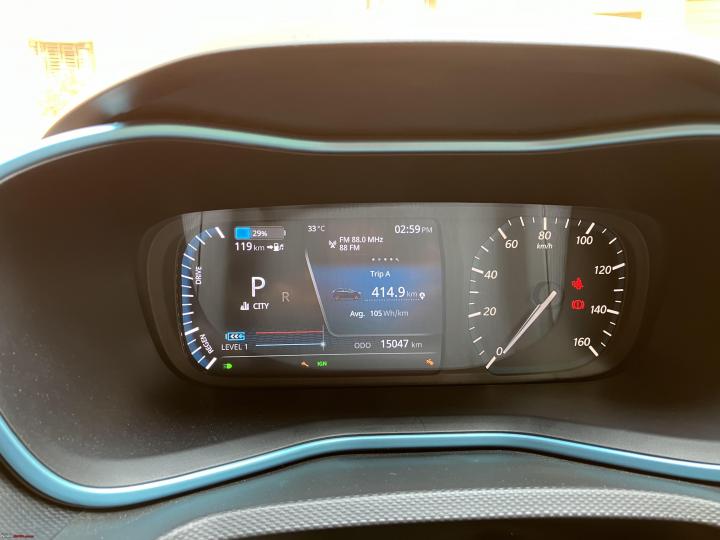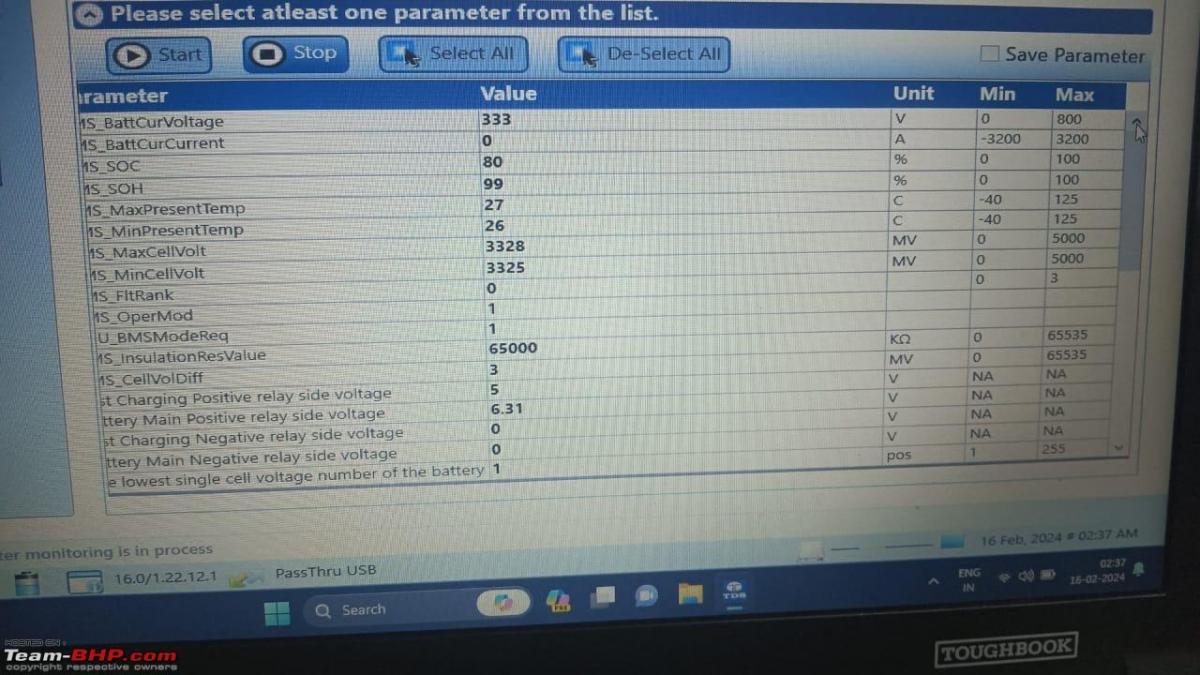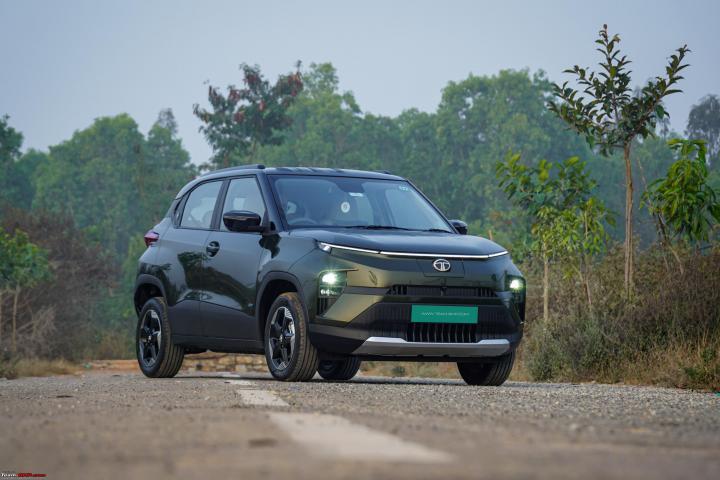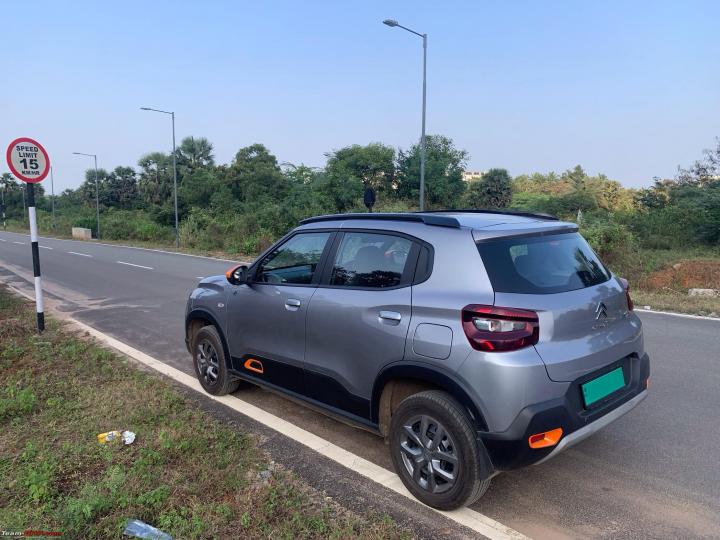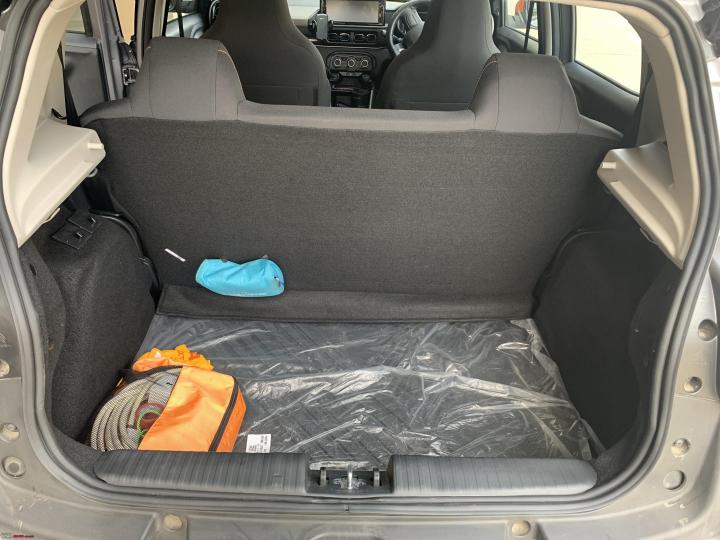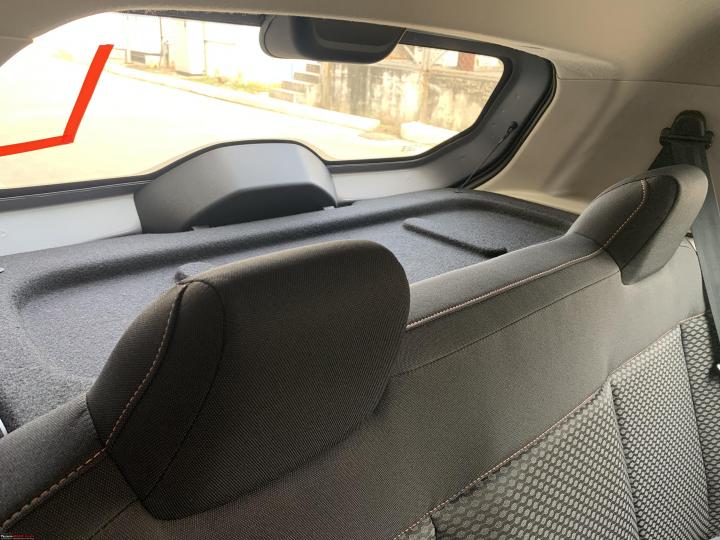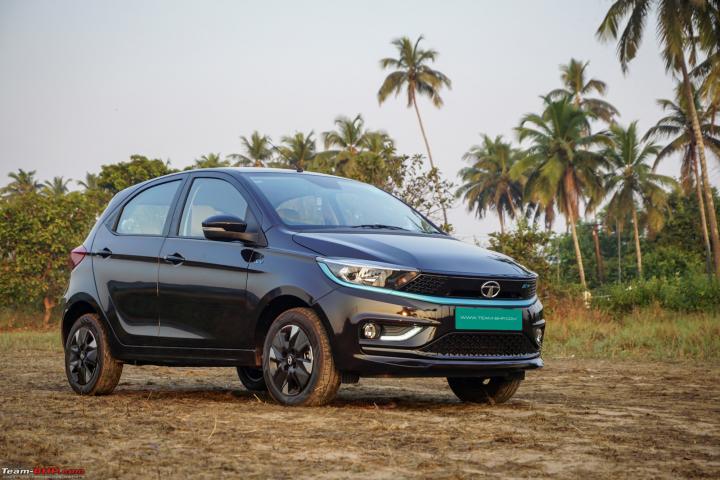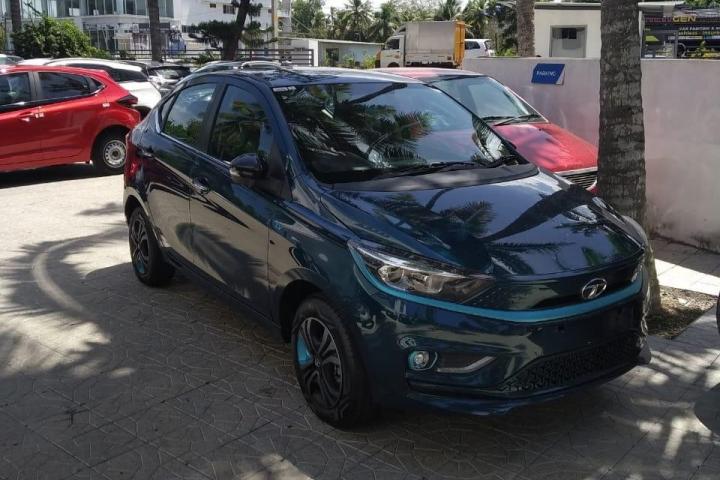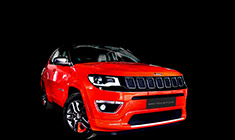News
Battery degradation in EVs: Is there a software to measure it?
I am concluding that my battery has degraded by 0.41% after 15,000 Km and nearly 10 months. Which personally is quite impressive.
BHPian navinmra recently shared this with other enthusiasts.
With the 15,000 KM mark coming up for my Nexon EV Max in around 10 months, I wanted to find out if the battery had degraded, and if so by how much. I have heard on some forums that Tesla batteries degrade by 1% per year so that fueled my curiosity.
On a recent journey from Bangalore to Manipal, I used data from the dashboard and the mid point fast charger to arrive at the battery capacity (and therefore the degradation) It is crude but I want to share with you all to see if you had any reactions:
- I started with 100% charge.
- At 49% SOC, I charged to 86% on a Zeon DC fast charger (pic attached)
- I reached my destination with 29% SOC after clocking 414.9 KM (pic attached
- My efficiency for the trip was 105 Wh/km
Now the calculation:
- Total energy consumed on the trip = 105 Wh/Km X 414.9 km = 43.564 KWh
- In terms of SOC % total energy consumed = 51% + (86% - 29%) = 108%
- Therefore 100% capacity = 43.564/1.08 = 40.337 KWh
Now, we know that the Nexon EV Max battery capacity is 40.5 KWh. Therefore a capacity of 40.337 KWh translates to 99.59%
Therefore I am concluding that my battery has degraded by 0.41% after 15,000 Km and nearly 10 months. Which personally is quite impressive.
I know this is very crude back of the envelope calculation and does not take into count residual battery capacity (not all capacity is made available to tap into) etc, but hopefully that triggers some thoughts amongst you all
Here's what BHPian mally2 had to say on the matter:
Interesting way. Or you can ask the TASS to check the SoH on the next service schedule. I did mine for the tiago.ev @ 15k kms and the SoH was 99%. Since there is no further decimal I had to assume that the degradation is around 1% or less. There are others in the tiago community who have done 25-30k kms and it’s still at 99%
Here's what BHPian Redex had to say on the matter:
Many "degraded" batteries are actually down to the way the user charges the battery, especially in earlier models. The early software was not based on endless "top ups" but engineers assumed that users would drive until nearly empty then do a full recharge. Try, fully charging the vehicle then park it up off road, leave the heater and air con running until the system shuts down. Recharge and repeat. Then recharge and check the SOH. Slow charging whenever possible helps.
This is simple non technical advice, not going to get into the realms of battery repair.
Regards Neil
IMI Level 4 Diagnostics and Repair Qualification.
Here's what BHPian coldice4u had to say on the matter:
Battery degradation for the current Tata vehicles should be a non issue. I agree with the comments that batteries will outlast the car.
My Tiago EV at 14k kms showed a similar SOH of 99%. This is after one season of intense NCR summer and one season of prolonged NCR winter. I've exclusively slow charged during overnight charging and to 100% each time. If we can extrapolate!, i expect battery degradation to hit 10% at 150k kms,but its a bit early to see that long into the future. At 10% degradation, total range with AC will be 150-160kms.
Very very happy with the car, barring minor niggles. Nothing beats this car for a city use case. No issues observed. Bad FM again as reported on other Tata threads, thats Tata being stupid with cost cutting.
Read BHPian comments for more insights and information.
News
Tata Punch.EV vs Tata Tiago.EV vs Citroen eC3 vs Other electric cars
Punch EV is superior & not that far away in terms of pricing from the Tigor EV.
BHPian Ripcord09 recently shared this with other enthusiasts.


Tata Punch.EV:
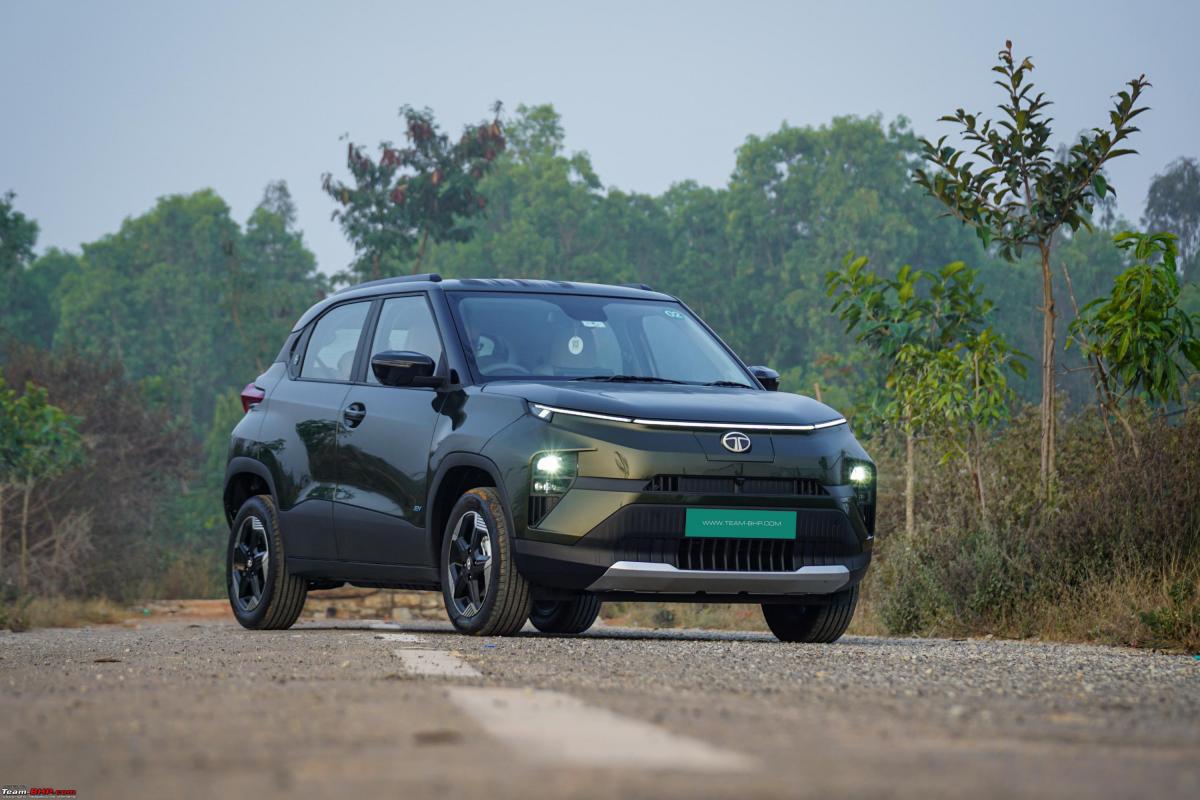
What you'll like:
- A well-rounded EV package at an affordable price tag
- Punchy 121 BHP motor is enjoyable. 300 km real-world range is adequate for most people
- Zero emissions, cheap “fuel” costs, no gears, light controls & compact size make it an ideal city car
- Enjoyable 6-speaker Harman ICE. One of the better systems in this segment
- Sorted road manners & reassuring high speed stability
- Well-designed & practical cabin with enough space for 4 adults
- 366-liter boot is accommodating
- Loads of features such as ventilated seats, auto-dimming IRVM, multi-mode regen, cruise control, Arcade.ev apps, air purifier, wireless smartphone charging, sunroof and more
- Safety kit includes 6 airbags, disc brakes all-round, ESP, electronic parking brake, auto hold, blind spot view monitor, hill descent control, SOS calling function, etc.
What you won't:
- Fit, finish & interior quality in some areas have room for improvement
- Suspension has a firm tune (R16 variants). It is compliant & liveable, but you do feel bad roads
- The usual EV challenges (charging infrastructure, brand new tech could mean niggles, range anxiety)
- No spare tyre, you will have to make do with a puncture repair kit! Good luck cruising on highways without a spare
- Cabin width makes 4 adults welcome, not 5
- Some missing goodies such as a split rear seat, rear A/C vents, spare wheel…
- Tata's after-sales service quality is a hit or miss. Remains a gamble
- It's a brand-new car, so the probability of issues & niggles is high
Tata Tiago.EV:
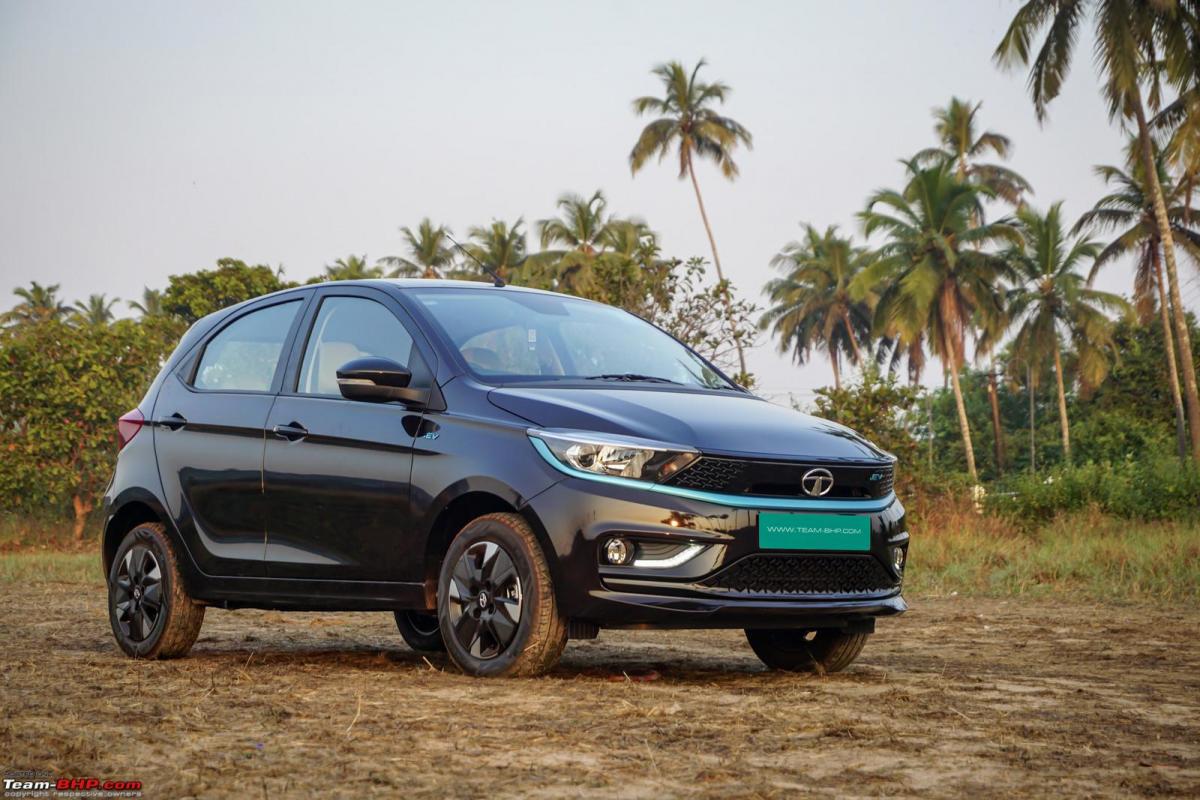
What you'll like:
- A well-rounded EV package at a sub-10 lakh rupee starting price. Total value-for-money
- Zero emissions, cheap “fuel” costs, no gears, light controls & compact size make it an ideal city car
- Real-world range of ~200 km is adequate for city commutes & urban dwellers
- Peppy behaviour in "S" mode! "D" mode is rather tame though
- Selectable regenerative braking is a very welcome feature
- Sorted road manners due to the lower center of gravity & firmer suspension
- Well-designed interiors are likeable & user-friendly
- Features like the 8-speaker Harman audio system, cruise control, auto headlamps & wipers, connected car tech & more
- Solid build & construction. Tigor EV's 4-star GNCAP result is reassuring
What you won't:
- A stiff 4-lakh rupees more expensive than the Tiago Petrol AMT. You're paying for the tech & being an early adopter
- The usual EV challenges (charging infrastructure, brand new tech could mean niggles, range anxiety)
- ~200 km range means this is strictly a city car. No long highway runs
- Stiffer suspension than the regular Tiago means you feel more of the road. Bad roads are felt
- Power tapers off after 100 km/h; top speed of just 120 km/h
- No spare tyre, you will have to make do with a puncture repair kit. We suggest buying a spare
- Some misses such as "P" mode on the shifter, alloy wheels, adjustable rear headrests, etc.
- Rear headroom is tight. Also, a rare Tata car that cannot seat 5 (best for 4 adults)
- Tata's after-sales service quality is a hit or miss. Remains a gamble
- It's a brand-new technology, so there will be issues & niggles
Citroen eC3:

What you'll like:
- Funky-looking electric hatchback. Crossover styling cues will appeal to the masses
- Real world range of ~200 km is good enough for city driving and urban commutes
- Zero emissions, cheap “fuel” costs, no gears, light controls & compact size make it an ideal city car
- Sorted handling characteristics, due to the lower center of gravity
- Good-looking cabin that is practical too
- 315-litre boot is very usable and fits a 15-inch spare wheel underneath
- 10-inch touchscreen with wireless Android Auto and Apple CarPlay. Now gets connected car tech as well
- Lots of customization options and accessories to make your car truly unique
What you won't:
- 56 BHP motor isn't very fun-to-drive. Top speed is limited to just 107 km/h
- 200 km range makes the eC3 strictly a city car. Not ideal for long-distance travelling
- No fast AC home charging even as an option. Either wait 10 hours or find a DC fast charger nearby
- The usual EV challenges (charging infrastructure, brand new tech could mean niggles, range anxiety)
- Quality of cabin materials doesn’t feel great; cost-cutting is pretty evident in certain areas
- Missing plenty of features – adjustable regeneration, climate control, wireless charging etc.
- Cabin width makes the interiors suitable for 4 adults, not 5
- Long-term reliability & after-sales service quality are big unknowns; dealer network is tiny
MG Comet EV:
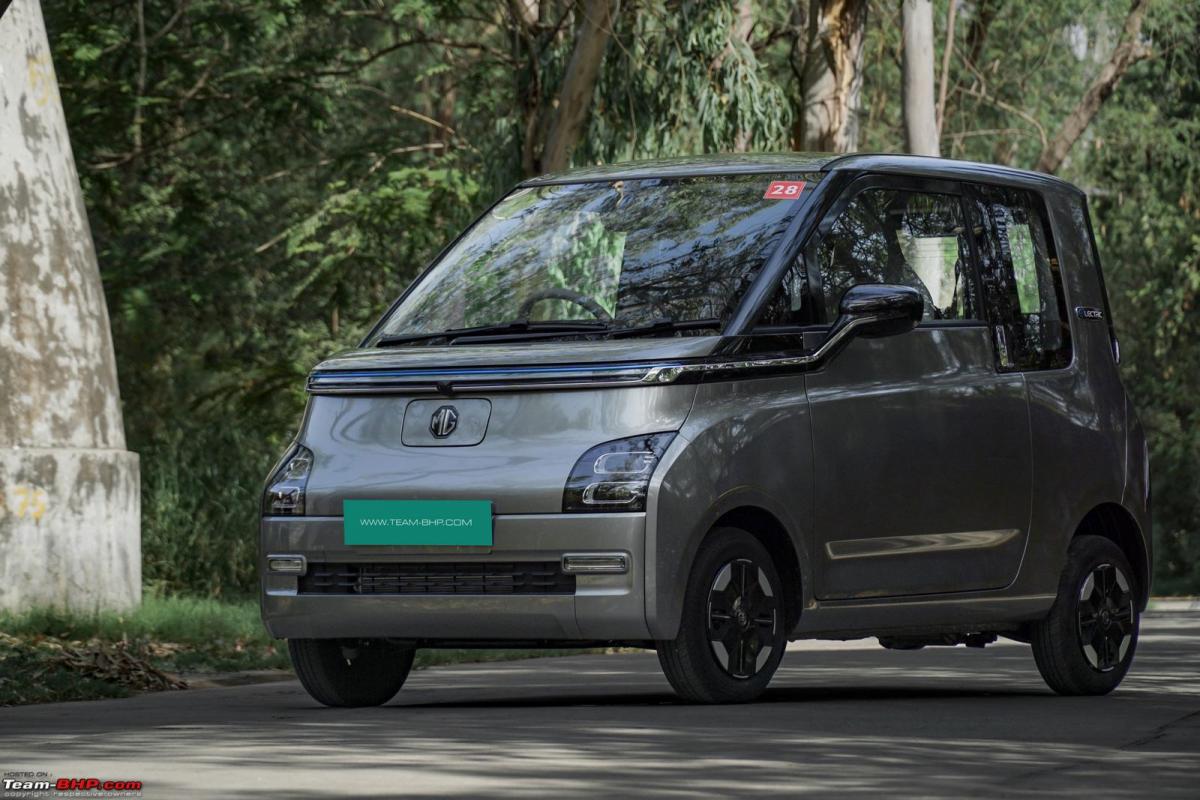
What you'll like:
- An affordable EV that focuses on personal mobility
- Ultra-compact size, light steering and small turning radius make it perfect for crowded cities
- A well-built hatchback that doesn’t feel cheap
- Real world range should be 150 – 160 km which is enough for an urban commuter
- Adjustable drive modes and selectable regen braking are useful in various driving conditions
- Zero emissions, cheap running costs & green image will appeal to a lot of people
- Good-looking cabin that has adequate space for 4 people to drive around town
- Tech includes a 10.25-inch touchscreen with wireless Android Auto & Apple CarPlay, connected car benefits, a cool starting procedure (no button to press), digital key sharing, etc.
- Good feature list includes LED headlamps, indirect TPMS, keyless entry, split folding rear seat, reverse parking camera with sensors, etc.
- Plenty of customization options and accessories to make your car truly
What you won't:
- Weird, funky styling may not appeal to everyone
- Not for people who want to do highway runs. This car is strictly for the city only
- 2-door design means difficult rear seat access. Also, it is a 4-seater, not 5
- 41 BHP motor isn’t fun-to-drive
- Can be used only as the 2nd or 3rd car of the house. Surely not your primary vehicle
- Zero boot space with all the seats up. You’ll have to fold the rear seats if you want to carry any luggage
- No DC fast charging or even AC fast charging options. Just home charging is available which takes 7 hours for a full charge (10 – 80% in 5 hours)
- The usual EV challenges (charging infrastructure, range anxiety, setting up home charging etc.)
- Missing features like seat height adjustment (tall drivers would want to lower the seat), rear washer and wiper, spare wheel!!
- 2-speaker sound system is just sad
Tata Tigor.EV:
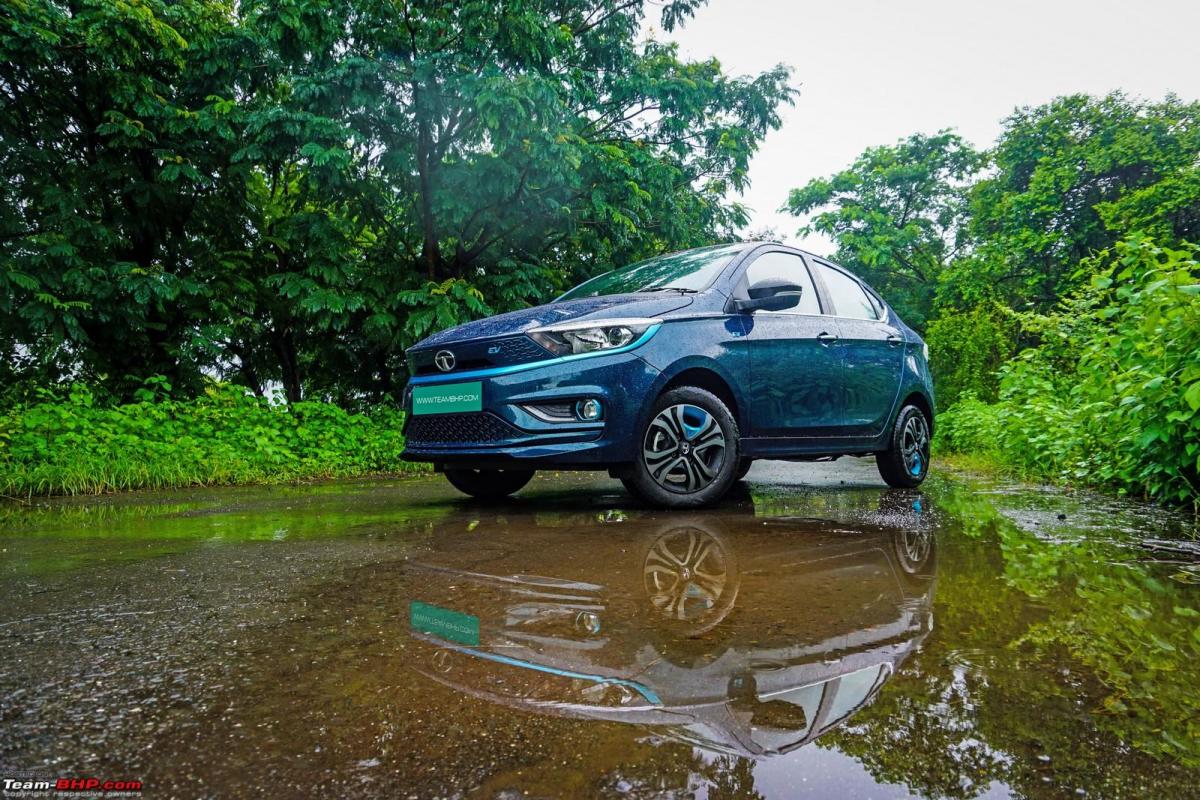
What you'll like:
- A competent EV package at an affordable starting price
- Zero emissions, cheap running costs & green image will appeal to a lot of people
- Real-world range of ~200 km is adequate for city commutes & urban dwellers
- Peppy behaviour in "S" mode! "D" mode is rather tame though
- Sorted road manners due to the lower center-of-gravity & firmer suspension
- Well-designed interiors are likeable & user-friendly
- Features like the 8-speaker Harman audio system, projector headlamps, connected car tech & more
- Solid build & construction. 4-star GNCAP safety rating is commendable
What you won't:
- A stiff 5-lakh rupees more expensive than the Tigor Petrol AMT
- Punch EV is superior & not that far away in terms of pricing
- ~200 km range means this is strictly a city car. No long highway runs
- Stiffer suspension than the regular Tigor means you feel more of the road. Bad roads are felt
- Power tapers off after 100 km/h; top speed of just 120 km/h
- Smaller 316L boot (regular Tigor = 419L) due to the intrusive spare tyre
- A rare Tata car that cannot seat 5 (best for 4 adults)
- Tata's after-sales service quality is a hit or miss. Remains a gamble
- It's a brand-new technology, so there will be issues & niggles
- The usual EV challenges (charging infrastructure, range anxiety, setting up home charging etc.)
Here's what GTO had to say on the matter:
Between the poll choices, I'd go for the Punch EV. It's clearly the superior of the lot. However, I have voted for "Other". Am not price-sensitive & would spend the extra bucks to buy a Nexon EV from the same showroom, or a ZS EV.
Check out BHPian comments for more insights and information.
News
Tata Tiago EV: How I ended up buying the car & tech I disliked the most
On our first visit I had told the SA that we were not likely to buy Tiago and were more interested in buying Comet however were just checking the car.
BHPian nik0502 recently shared this with other enthusiasts.
I always disliked the First Gen Indica for how it looked. Over the years lot of changes happened to the original Indica design and it was renamed multiple times like Vista, Bolt however more or less it still looked like original Indica. And that same design started putting me off. It became one of the most disliked designs by me.
Coming to the Electric craze. I always felt EVs are still far behind in terms of what they offer for the price and also they also lack practicality. I like driving non stop. I am always in a hurry to reach the destination. Hence all my drives are non stop. Even the 600 - 700 kms one. So I would hate to stop just because the car needs a break for charging. One of my very close friends had booked Nexon EV last year and I convinced him to cancel the booking. He ended up buying ScorpioN 4*4. I was certain that I would never buy an EV in life. But life had other plans.
The buying decision
I didn’t have any plans of buying a new car however It was Christmas Eve and I was out buying groceries when all of a sudden a thread of Comet EV Popped up on my Facebook feed. The title mentioned about heavy discounts on Comet EV and the available subsidies. So long story short the Comet EV was supposed to cost 6.2 lacs for base variant. This drew my interest and I finished the entire thread. Discussed this with my wife and she had a liking for Comet since the time it was launched.
I am currently living in Chandigarh and my daily running is 22 km in very heavy traffic. And one 600 kms drive to Delhi NCR every month. My other cars are 2020 Ecosport Titanium Plus AT and Honda Civic VAT. Currently both these cars are doing the duty of a daily runner with Civic already crossing 1.25 lac mark.
I am soon supposed to move back to NCR and my daily running would be 100+ km. I was preparing myself mentally for a daily fuel cost of 800-1000 rupees since I didn’t want to buy another car spend big amount just to get a comparatively lower running cost. However suddenly the idea of buying Comet popped up in my mind and it started making sense. Buying Comet would have meant I would be spending a lot less on fuel plus EMI as compared to my expected monthly fuel cost. I called multiple MG dealers in NCR and Chandigarh. While all of them promised to arrange a call back but I got none. Frustrated I called TATA motors and they happily shared the price details and available discounts.
I decided to drop by the MG showroom personally to check out the car in person and enquire the discounts along with a possible test drive. I hadn’t driven an EV so far in life. Unfortunately got stuck in a 2 hours plus traffic jam due to Christmas. And was unable to reach the MG showroom. There was a TATA showroom nearby so decided to check out Tiago instead. I had to park the car in TATA commercial vehicles dealership since the road in front of TATA passenger vehicles was completely blocked by traffic. The guard at commercial vehicles unit asked us not to park the car there however my wife told him that he would be turning a potential TATA customer away. Though the guard didn’t force us to move the car however he was very rude throughout. I wasn’t very surprised since I had a horrible time with TATA at the time of Harrier launch. The car was under serious consideration but we decided to turn it down due to dealership’s attitude.
We entered the passenger vehicle section and enquired about Tiago EV. There was a white colour XT variant parked inside the dealership. My wife didn’t hate it as much. Though she never liked it her first reaction on listening about Tiago EV was “it just looks like another Alto”. No offence to Tiago EV owners.
Checked about the price and I had XT Medium Range in my mind since it would have been a little over the initial plan of spending ~ 7 lac on EV. There was a healthy discount and delivery was possible immediately. I didn’t need a car that fast and I was sure we weren’t buying Tiago EV. Took the price sheet and left for MG dealership. Ended up walking about 1.2 KMs because of the traffic jam. Reached MG showroom and there was no display vehicle which I hadn’t expected. There was a test drive vehicle parked in the basement. The team offered me that car so that I can check it. The car was just okay. I couldn’t take a test drive since the battery was barely 2%.
Asked about the discounts and the SA mentioned there was hardly any. With the discounts quoted Tiago EV was costing less than MG for same set of equipment and Tiago was a proper car. My daily commute would be between Faridabad and Gurgaon which includes a hilly road with some sharp turns. I had an apprehension about the Comet EV from safety perspective on this route. Though it’s a beautiful city car but the use case is very limited. Once we reached home my wife mentioned she was not as impressed with Comet. So there it was. I convinced her for Tiago EV. She didn’t like both the cars and said it’s better that we continue with our current cars. After some discussion she agreed that it might not be the best of the purchase but it would make a lot of sense.
On our first visit I had told the SA that we were not likely to buy Tiago and were more interested in buying Comet however were just checking the car. The SA Aman was still very welcoming and helpful. So I called him up. And informed him that I am ready to go ahead and buy the car but need a test drive first. I couldn’t take a test drive because of working days so on Saturday 30th I took a test drive and was very underwhelmed. All that talk about smooth drive no noise and everything I didn’t feel any of it. Probably because I have been driving Petrol cars only all my life. Then next thing was the availability of torque from 0 rpm. Again didn’t find anything different here probably because the current cars are already peppy. The sports mode was great though.
Asked for 30 minutes time after test drive to confirm for the booking. Discussed with wife and she confirmed that I should go ahead with the booking. Till this time I wasn’t even sure if I should buy another car. Booked a white coloured XT variant (Long Range). This variant makes a lot of sense since the on road cost is less than 10 lacs and you get all basic equipments. Couple of things that were bothering me with XT variant. Lack of defogger and fog lamps. And I really like the keyless entry feature for its convenience. Decided to upgrade the booking to Top variant. So upgraded the variant to the top variant on 31st. The SA had a car which had arrived just one day ago and allocated the same to me. I asked for the VIN and the SA happily obliged. It was a December 2023 made unit. I did the PDI and gave a go ahead. Loan was applied under my wife’s name and was approved the same day. Surprisingly the dealer was ready to deliver the car on Bank Delivery Order. My friend had taken the delivery of Scorpio N and the delivery was delayed in his case since the payment wasn’t credited to dealer’s account on the day of delivery and dealer denied the delivery even after confirmation from the leasing company that the payment had been initiated.
Till 3 PM on 3rd January I had no plans of taking the car that day. Was waiting for the weekend. However got the call from my SA that the car is ready for delivery. I wasn’t aware that the registration process is completely online now. Not sure if it is only in Chandigarh or across the country. The registration took less than 30 minutes and I had the permanent number issued for the car. After discussion with SA I headed home dropped Ecosport. Booked an uber and reached dealership at 5:45 with my wife. Completed balance payment and paperwork. Got the delivery at 7:30 PM.
Headed to the temple where customary pooja was done and headed home at 9 PM. Took an off next day to complete some formalities for the bank. And the car threw first niggle.
More on that later.
There was no excitement about the car in the family. Probably because it was first time everything was overlooked in favour of practicality. The car was parked for next 10 days and kept gathering dust. Even the caretaker of the house who is more of a family member was sure that it was a wrong purchase and didn’t bother to wash the car.
I wanted to upgrade the tyres and the wheels however wasn’t sure about the drop in range and couldn’t find anything on the web. Was going through the official review thread where I saw a bhpian had already upgraded the tyres to 185 section. Thank You BHPian Altman for clearing the doubts about this upgrade. So after spending 10 days in hibernation the car went for a tyre and wheels upgrade. I checked multiple stores however couldn’t find alloys which I would like in the first instance. There weren’t many options in 14 inch size. Finally my wife selected one and decided to go ahead with it. Though these are little loud for my taste. Decided to go with Yokohama 185 section since Michelin are still not easily available in the market.
The wheels and the wider tyres changed the stance of the car completely. The car was driven 40 kms that day and was run ~ 90 km in total and it needed a charge. I don’t have a charging option at home and don’t want to install one also since I will be moving soon. So took the car to work next day and put it on charge. It took 7 hours to charge from 30% to 100%.
The car has been consuming unexpectedly high energy which I will discuss in detail later.
Overall experience is neutral. The car isn’t exceptional in any aspect but does everything well. If one keeps the expectations low the car will keep you happy.
Positives
- Proper car at affordable price as compared to competition.
- I will be charging the car at work for most of the days so no running cost.
- Quality of materials used is acceptable. Nothing that stands out but nothing that would scream cheapness also.
- Top variant is loaded with features i.e Auto headlights/ wiper, keyless entry and push button start, faux leather seats etc.
Negatives
The list is long
- Usual TATA niggles.
- Sad Harman music system. It probably is decent for the price of the car however what’s worse is there is no option to upgrade either. Any changes to the electric components of the car will void the warranty. Even if done at dealer level. This is going to haunt me for a long time.
- No option to customise. You can’t change anything in the car unless you are ready to let go of the warranty. TATA is not allowing any modification or changes to the car. Slightest change will result in issues with warranty.
- Lighter build means a lot of outside noise filters in the cabin. I would need to get the damping done soon. Not sure what can be done with the thin windows glass.
- No tinted glasses means it’s going to be difficult in North Indian summers. Plus it would have saved some amount of battery also.
- Huge variation in claimed Vs actual range. MG is claiming a range of 230 and customer reports on Team bhp state they are getting ~ 180 kms on the other hand the highest claimed range I have seen on the reviews is 240 kms.
- The rear bounces more than expected on big speed breakers.
- The headlights are just average. Could have been a little better.
- Negligible heating in the cabin. Unlike ICE cars where the heater works by tapping engine heat however EVs need a heating coil. The heating effect of these cars is good to keep the cabin temperature ambient however the heating effect itself is bleak. Also the battery consumption will increase by 200% if heater is used. I have a habit of keeping the blower always on at level one and keep the air flow on the feet to keep them warm in extreme temperatures we see in northern part of the country. Now I have to travel with my feet frozen.
Issues and niggles
The first issue I faced was in the second day of ownership when the handbrake light started flashing. I checked the brake oil and it was fine and restarting the car solved the problem.
Second issue was the third day when I was driving. The infotainment screen went blank. Restarting the car solved the problem once again. The sad part is that there’s no dedicated display for climate control and if infotainment screen isn’t working you have no clue what temperature and everything.
The third one is something I am still struggling with. The range I am getting is very low the AEC is very high. And the application shows 50% battery is getting consumed by climate control unit even when AC and heater is completely off. I visited service centre and they asked me to discharge and charge the car four times and range should settle.
Fourth issue is with Zconnect App itself. The application is not connecting most of the time and will only work when the car is unlocked. This defeats the purpose of the App. Unlike conventional car as an EV user you are heavily dependent on the App. To check the charge levels while the car is connected to the charger. Imagine you living in a high rise building and you have to come down to the basement only to check how much your car is charged so you can plan your travel.
It’s been only 20 days since I have got this car and I am yet to find out if it was the right decision.
I believe TATA had a huge advantage of becoming the first mass producer of EVs in India and could have become the Tesla of India. However they are throwing it all away by not controlling the quality checks. The cars are having continuous niggles. Something or the other keep popping up and it is a big turn off for people like me who hate these visits to service centres.
Time for some pictures:
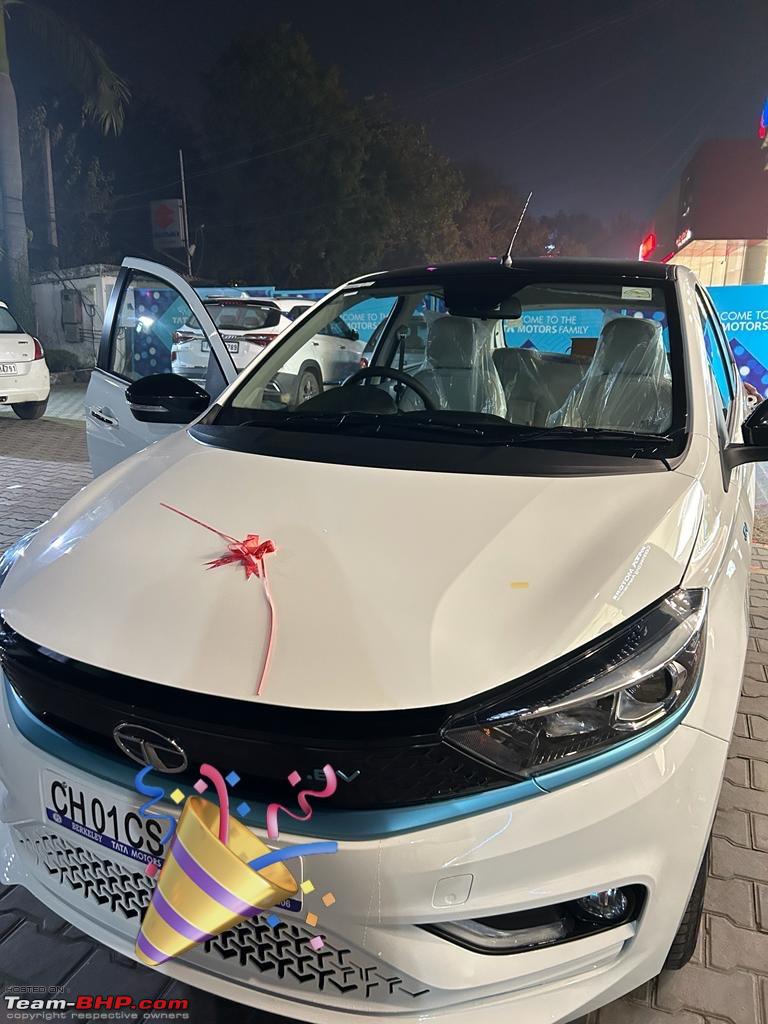


Read BHPian comments for more insights and information.
- Tags:
- Indian
- tata tiago ev
News
Used my Tiago EV extensively for highway trips: 3 lessons learnt
With the current infrastructure of 25 and 30 Kw chargers, no matter how hard you optimise your trips, your charging time will always be greater than your break time.
BHPian nithiraj recently shared this with other enthusiasts.
As a first time EV owner, I always had the doubt of time gained during a Highway trip by speeding up versus time gained by charging less. I regularly take one trip from Madurai to Karaikal every week, which is about 275 KM one way. Out of the 275 km, about 185 km is on a 4-way NH and the remaining 90 Km is on a 2 lane State Highway. I am usually a relaxed driver and rarely cross 100 KMPH on the 4-way highway. In fact, the roads here are good enough for me to maintain a cruise control set speed of 95 KMPH most of the time. I did 3 trips to find out which strategy is better. (For the sake of uniformity, I am just considering the onward trip - Madurai to Karaikal)
Trip 1
Vehicle: Suzuki XL6 Petrol AT (4 Speed)
Set 95 kmph cruise control for most of my first 185 kms and did a relaxing 50-70 kmph speed for the remaining 90 KM
- Total Trip Time: 4hr 55 mins
- Coffee Break: 10 min
- Effective Travel Time: 4hr 45m
Trip 2
Vehicle: Tata Tiago EV LR
Being XT trim, My Tiago EV does not have cruise control. So maintained a speed of 90 to 95 kmph for the first 185 kms and a similar relaxing 50-70 kmph for the remaining 90 KM. I got an average of 130 Km/Wh and hence had to make 2 charging stops. One on the outskirts of Trichy and the other in Tanjore. Started the Trip with 100 % charge and ended the trip with 20% Charge. So charging time was well optimised and I don’t think I could have reduced the charging time. I toped up 60% charge in total.
- Total Trip Time: 5hr 44m
- Charging time: 54m (40 + 14)
- Effective Travel Time: 4hr 50m
Trip 3:
Vehicle: Tata Tiago EV LR
This time around maintained a speed of 75 to 80 kmph for the first 185 km and a strict 50-60 kmph for the next 90 km. The average electricity consumption was a remarkable 105 Km/Wh. This enabled me to skip one charging break and just did one charging in the outskirts of Trichy. In this trip too I started with 100% and Ended up with 21%. I topped up 38% in total.
- Total Trip Time: 5hr 32 mins
- Charging Time: 36 mins
- Effective Travel Time: 4hr 56m
Inference 1:
Time gained by speeding up is always sacrificed by charging the vehicle for more time. The efficiency of the vehicle (Km/Wh) takes a significant hit and with the current charging speeds (18 Kw/hr for Tiago EV) it is very easy to lose time.
Inference 2:
If I had a vehicle with a better range (Read Nexon EV LR) I could have easily made the trip without a charging stop and in the same time as my ICE vehicle. This is true because of my already relaxed driving style. Had I wanted to push the vehicle to 110Kmph or more even the Nexon EV would have needed a charging stop.
Inference 3:
With the current infrastructure of 25 and 30 Kw chargers, No matter how hard you optimise your trips, your charging time will always be greater than your break time. The only way the mass is going to enjoy EVs without a compromise is to increase charging speeds – Both Vehicle side and Charger side. Only if we can top up 100 km worth of charge in 10 mins, everyone is going to enjoy EVs on the highways with out complaining.
I am sure such a future is not far away until then I love my first EV – ”Tedha hai par mera hai”
Read BHPian comments for more insights and information.
- Tags:
- Indian
- tata tiago ev
- Maruti XL6
News
Chose the Citroen eC3 over the Tiago EV & Comet: My experience so far
Tiago EV was certainly the hot hatch of the lot. Good dynamics, blisteringly fast in sports mode and a reasonable dashboard and display.
BHPian mathewanil recently shared this with other enthusiasts.
Speculation and criticisms, that what I’ve seen over numerous posts in Team BHP about this car that was launched about a year ago. Hi, I’m new to Team BHP and here is what I think of the Citroen eC3 after 3 months of ownership and clocking nearly 5500 km. I was in the market for a second car for daily commutes to work and an occasional weekend run. And I did the TDs like most buyers with a limited budget of around 13 L. The only contenders in the market were Tiago EV, MG’s Comet and Citroen’s eC3. I drive an average of 1200- 1500 km a month with daily commutes of 30 km to work and some local weekend trips.
My TD experience of the 3 aforementioned cars
Tiago EV was certainly the hot hatch of the lot. Good dynamics, blisteringly fast in sports mode and a reasonable dashboard and display. And like all budget cars in this segment there were always features that were desirable. To me the loud creaking sounds in the dashboard in the TD car, the lack of a spare wheel and limited boot space was a downer and reasons enough to not buy it. The lack of durability and some niggles are known with a few Tata cars and my talks with other local owners about their service experience in our place further confirmed my decision to not go for this model.
The MG’s Comet, small and funky looking with small 12-inch wheels and a 2-door configuration was great to look at. The interiors looked top notch and had a dash with the look and feel of an Apple device. My test drive experience however was not great. I do about 25 km of highway drive every day and while doing the TD on the highway, the car was buffeted by winds generated by passing heavy vehicles and large SUVs. The small wheels did not inspire confidence and the slow speed drive through rough terrain was not great either. This, along with virtually no boot space to talk of, meant this was not the car for me either.
The Citroen eC3 was the last car that I test-drove. What I immediately liked was the sense of space within the cabin, the no-fuss drivability and its fantastic suspension. The boot of 315 L is great and usable, and the presence of a spare wheel was reassuring. Sure, the dashboard display looked bare, and it lacked the bells and whistles of a modern car, but (IMO) the general fit and finish were far better than the TIAGO. There was the odd fuel lid at the back that was sealed, a key-start ignition, small IRVM and stick-controlled ORVMs. But having owned 4 other cars, I realise that the modern solutions to these are desirable traits but not essential. And although there were lots of negative comments and blogs about fast charging and the lack of liquid cooling for the batteries, almost 99 percent of these were by people who did not own this car.
To allay my fears the dealership shared a few phone numbers of other owners who had bought this car and I’m grateful I got to speak to a few of them before my purchase. So finally, I took the plunge and booked the “Feel” variant in monotone silver-grey car with “Vibe pack” (orange highlights on the ORVMs and around the back reflectors and front fog lamps). I also got a rear-view camera fitted as an accessory by the dealership. The car was registered and delivered to me in about a month. I purchased my own insurance and fast-tag as I already owned a Skoda Kushaq and knew that a little market research brings down the premium on PV insurance and any bank can provide multiple fast-tags linked to a single wallet.
Ownership experience of the eC3
The car is 3 months old. I’ve nearly done 5500 km already and here is what I think about owning an eC3.
Driving my eC3
I commute 30 km daily and I charge the car once in 5 days. At that point, I would have done 150 km and would have about 25 to 30 percent of charge remaining. As I come from an ICE car and drive this one like the Kushaq, I consistently get about 200 km mileage for a full charge. That’s roughly 2 km to a percent of charge. Most of my commute is on the highway. I drive at speeds between 90 to 95 km/ hr and occasionally I cross triple digit speeds while overtaking and a few times have even consistently driven it at 107 km/ hr (which is also it’s capped top speed). I always drive with my windows up and the AC on. It’s agile, the steering weighs up nicely with increasing speed and surprisingly has limited body roll for a tall design like this. The acceleration is linear and robust till about 60 km/hr and fades away a bit after that. All ICE powered cars and bikes are left behind at the turn of the signal at every traffic junction, leaving a few bewildered drivers in my rear-view mirror and a suppressed grin on my face.
The suspension is fantastic and driving on rough terrain is a breeze. This, added with relatively wide 195/65 R15 wheels makes for great driving. The car is quiet like all EVs with the occasional purr of the cooling system that kicks in every now and then and the constant drone of the AC compressor when on, all of which are heard only when outside and near the bonnet. Being a quiet car means honking more often to remind other road users of my presence. There is a loud beep from the dash when the motor goes on with the display saying “ready” to remind us that the motor has started.
The NVH levels within the cabin are quite good but tyre and wind noise is quite prominent after 80 km/ hr. It has great highway manners, good steering control, fantastic suspension and (to me and my wife) well-contoured seats. It lacks the variable regen that’s there on other EVs but has an ECO mode that adds regen-like dynamics to the driving. To me, it means, near single-pedal driving with less braking in regular city driving and the ability to slow down at corners or for speed breakers and while driving down steep inclines by just taking off the foot of the throttle. It has a tight turning radius of 4.9m; however, the toggle switch is not fast and the flick from reverse to drive is a slow affair. The ground clearance of 170mm is more than adequate, a cm less than its ICE counterpart.
The battery pack under the floor and the engine (motor) room is covered with a casing for protection and the ground clearance has been maintained inspite of this. The car has a creep function in D mode, but no hill hold control. It does roll back a bit before creep takes over. This will either require a lightning-fast brake-to-throttle shift or the use of the hand brake. I've noticed with the use of the parking brake, the car shifts to a neutral-like mode and although it's in “drive” it needs a little more throttle input before you release the hand brake. This makes it a bit difficult with traffic on an incline. The reverse mode also has creep however less intuitive than the drive. It has a kind of all-or-none throttle response which also could have been better. Driving upslope in reverse is not easy and not recommended with this setup.
Features and gizmos and the lack of it:
The feel variant comes with a 10-inch infotainment system. It’s ok, boasts of wireless phone connectivity but not the best in the market. There are a few periods of loss of phone mirroring, and it takes a while to reconnect to my iPhone. Occasionally the screen freezes and then it's up and running after a bit. The sound quality is decent but not over the top.
The dashboard display looks like it is taken from 1980s arcade game consoles and has a pictorial representation of the battery percentage, the power usage and the speed and the drive mode quite clearly. The range, odo, tripmeter and battery percentage can only be seen by pressing a toggle switch on the display, forcing you to put your hands through the steering wheel while driving. And whoever designed that needs a demotion and has to be sent back to design school. To its credit, whatever is on display is crisp and large enough for me to read with my old man, presbyopic eyes without bifocals.
The ORVMs have manual toggle controls and I’ve added blind spot convex mirrors on top of them. I’m fairly able to do good parallel parking, even in tight spaces aided by the ORVMS and reverse cam. I guess three decades of driving and using barebones cars in the past has helped. The lack of powered mirrors although not a deal breaker would certainly be desirable while adjusting the passenger side mirror for some tight parking. The C pillar is quite wide and is a big blind spot if you are used to reverse parking by looking over your shoulder. The IRVMs that now boasts of manual dimming is minuscule for my use and I’ve added a wider convex mirror on top for my use. I’ve done that for my Kushaq too.
The lack of climate control is a bummer. I’ve bought my car in October and the morning drives are a bit chilly. The temperature control knob is usually set at the first red line during early morning drives and the onboard heater (yes! It actually has one) kicks in immediately. Turning the thermostat control back a notch to cool, the point between the blue and red dashed lines, immediately switches on the air conditioner and kind of makes the cabin cool immediately. It’s ok for the rather hot summers as the car cools rather quickly but it’s not great when it’s cold outside and you would like to find the just the right temperature that’s comfortable for you. I guess I’m spoilt by the Kushaq which has climate control and can adjust the temperature in increments of 0.5 degrees. Dare I say the cooling capacity of the eC3’s AC is more robust and quite fast and effective. This added with the light tint on the windowpanes makes for a comfortable cabin even after being parked out in the sun.
The AC however lacks the HEPA filter that I’ve seen in European cars. In very polluted areas, some chemical smells have drifted through into the cabin, even in recirculation mode of the AC and that’s forced me to buy a low-end, cabin air purifier that’s solved this problem. The lack of a rear defogger and wiper is also troublesome during rains and foggy days. I wonder why these are considered optional on hatchbacks. The stock front windshield wipers are about the same quality as the ones I had on my Maruthi Omni from a couple of decades ago and I’ve recently replaced them with BOSCH Aerotwin blades which has made a huge difference while driving in rain. The headlights, DRLS and indicators are good and like all OEM Halogen setups just short of optimal.
Home (AC) charging
I spent an additional 50 K for the purchase and installation of a wall charging unit by Zevpoint. This was installed by a local electrician to one of the pillars in our parking lot of the apartment where I stay. This included a 6 sq mm 3 core wire that was brought from the main power control room for about 40 meters, an extra power meter to log my power consumption., a dual pole MCB switch, a SPD (spike protection device) and and a RCBO switch to prevent back-current flow to the circuit. These are akin the wall unit provided by TATA to connect the portable 3.3 KW charger to. Citroen has now included this as standard for all eC3 vehicles and that is why there has been an increase in price of ₹ 11,000. The Zevpoint charger cost me around 30 K during an Amazon sale and although it can charge at 7.2 KW, this car will charge only at 3.5 KW/hr. So, adding a 7.2 KW charger has not significantly reduced my charging time as compared to the portable unit that came bundled with the car. This I realised after installing the wall charger from Zevpoint and although I could have returned the charger and got a full refund, I decided to keep it.
Since my parking is on the ground floor of an apartment complex, the charger can be locked by an onscreen password to prevent misuse or accidental electrical injury. The charger also allows delay start to allow the battery to cool down before initiating charging if needed. It logs the power consumed at each charge cycle and also the cumulative power consumed over time. The current output can be varied on the charger if needed and I’ve seen it charge at a constant 3.5 KW output which is marginally faster than the portable charger that came with the car. In my weekly charge cycle of bringing the car from about 25 percent to full requires about 8.5 hrs of overnight charging. Although the dealership recommends that the car can be charged with any socket with a 15-amp output, it is recommended that the gauge of the wires used, the quality of the socket and switches are up for the constant load for 8 to 10 hrs.I noticed the switchboard warming up during AC slow charging at my parent’s house which was promptly solved by a small table fan throwing cool air at it.
DC fast charging:
This is where it gets interesting. For all the criticisms that are written in the blogs by people who do not own this car, my DC fast charging experience has been fantastic. The only rider is that I’ve been doing this testing from October to December, and I’ll update my summer experience after a few months. I stay in Vellore, Tamil Nadu with an ambient temperature of 33 to 35 deg C during the day in winters and I’ve done a couple of Bangalore trips (240 km from where I am), a ride to Chennai (130 km) and a long trip to Kerala (600km one way) and further trips within Kerala where day temperatures were considerably higher. The trip to Bangalore required a single top-up on the way and then AC charging (to full) at my Parent’s home. The chennai trip did not require a top up on the way and I reached the destination with nearly 45 percent of charge. It required one top-up at the destination, and I was able to drive all the way back. The longer trip could have been done with 4 top ups on the way, however being the first time, I decided to use multiple chargers to log in my experience. I did about 12 consecutive DC charges in all, including the to-and-fro commute and my local travel there over a week, clocking about 1600 km. Barring a couple of times due to charger issues, the charging worked like clockwork, and I had no issues whatsoever.
Since the car can charge at a maximum power of 30 KW/ hr its ideal to charge it with a DC fast charger that is rated 30 KW and above. I personally feel that the charging at 50, 60 and 80-KW charging stations were the least time consuming because the 90 amps current output was easily achievable by these chargers. The charging is fast till it reaches 70 percent SOC (30KW/hr), drops a bit after that to 24 KW/hr till it reaches 80%. After that it charges at a rate of 16 KW/hr till 90% SOC and beyond that at 6KW/hr and later 3 KW/hr. In simple terms the charging time doubles if we attempt to charge to full. Most charging stops took about 35 min, some a little longer. It did add about 3 hrs to my travel time and would be troublesome for a family with kids. I did these long commutes alone on the eC3 which irritated my wife, since she would have preferred me taking the Kushaq.
However, the long charge times was a forced rest during the journey and ensured I got more than my required share of power-naps during my travel. The bright side of long wait times to power up the car also meant meeting other EV owners, shared coffee or tea and some interesting stories. So, long commutes need a bit of planning, and the ideal target SOC should be around 80 to 85 percent if there is another charger in the next 140 to 150 km distance. I have downloaded all EV charging apps like Ionage, PlugShare, Charge Modd, Charge Zone, TataPower, Zeon, Relux electric, Shell recharge, Jio BP, GOEC and Statiq. I have also sourced the RFIDs from most companies that offer them, and I find that DC charging is just a plug and play affair after using one of these. I’ve used all the company apps/ RFIDs at least once. The rates of charging in Karnataka and Tamil Nadu vary between 25- 30₹( incl of GST) and about 12- 15₹ in Kerala.
Long trips will require you to save markers on your google maps to give you an idea where the next charger is. I did that painstakingly by opening each app and saving their corresponding charger locations on my google maps along the route that I was deemed to take. The query for “EV chargers” on Google maps is not perfect and does not have filters for the type of charger available. Ionage and PlugShare apps kind off fill in for this deficit but still have a long way to go.
Among the various companies that offer DC fast charging, Shell and Zeon are the most expensive with Relux coming a close third. Zeon has been the most consistent with excellent support and a good network, while Relux is ok, with not-so-great support. Jio BP is by far the cheapest in Karnataka but has poor penetration. Statiq has a poorer network but my experience with them has been good too. GOEC in Kerala is fantastic and my preferred service in Kerala. My overall cost of running has been ₹2.32/ km with a 60 percent fast charge and 40 percent slow charge cycle. It’s roughly 1.5 ₹/ km for slow charging (I pay about 8.4 to 8.9 ₹/ unit at home) and 2.93 ₹/ km for DC fast charging.
Claimed Efficiency and driving styles:
This car comes with a claimed efficiency of 320 km, but the range meter always shows 230 km on full charge. The real-world numbers are around 200- 210 km. My daily commutes consume about 110- 120 watts/ km. My long highway runs have consumed about 120 to 150 about 120 to 150 watts/km. And consistent max speeds consume about 180 watts/km. In real world figures it means driving between 85-90 km/hr and city drives will give a range of 205 km, 90 -95 km/ hr around 190 km and at max speeds around 160 km. Ya so if you are looking at range and keeping anxiety at bay, drive like your grandfather and keep the windows down and switch off the AC. Or drive like you own an ICE car having decided where your nearest fast charger is. The main power unit is a series motor whose torque delivery for accelerations and overtake is quick and robust, but the output has been tempered for linear accelerations and not outright performance. Quick overtakes are fun in the city but needs a bit more planning on the highway. I’ve almost always run on ECO mode, more for the braking effect while letting off the throttle than anything else. It lacks a brake light indication on decelerating (without pressing the brakes) and this would certainly be desirable in preventing tail-ending by other vehicles coming from behind.
EVs and software glitches:
These are common among EV cars and something the owners come to live with. There have been at least a dozen warning lights that have come up on the dashboard over the last 5000 km. Most of them disappeared in a few seconds and some after a start and stop of the ignition. To be fair, the service personnel at the Ramani dealership at Chennai have always responded to queries and have been reassuring. But the downside of this is that the sensors / warning system is unreliable, and an owner would never truly know when there is a problem.
Service
Citroen does have a small footprint in India. And if there is reason to not buy this car, this will be it. They started a new showroom at Vellore and service will be available shortly. I bought my car at Chennai and did take the car back once for a 2000Km check-up. The service center was crowded with C3 cars (ICE models) and although I reached there pretty early, I did get the car only be evening. There was some software update to do, a general inspection and a water wash. Some accessories like the steering wheel cover and sill plates needed some refitting since the first time, these were done sub-optimally.
In summary, here is what an ideal EC3 should have:
- Rear defogger and wiper
- Climate control AC
- Cruise control
- Brake light warning on throttle off
- Better stock wipers
- A software update for their infotainment
If you can overlook these, it’s a fantastic car to drive, with great dynamics, responsive throttle, superb ground clearance, a good boot with a spare wheel and a quiet and roomy cabin.\
Read BHPian comments for more insights and information.
News
Buying used electric vehicles: Yay or nay?
Hardly any independent garage has the knowledge or equipment to fix EVs. And where will you get parts? Brand-new Tata EVs spend months in the workshop waiting for critical parts.
Do used EVs make a strong case for themselves?
Here's what GTO had to say on the matter:
No chance. We're still in the very early stages of EVs & manufacturers are taking big leaps ahead every year in terms of technology. Reliability too, since it's a big learning curve for OEMs, supply chains & workshops. v1 EVs of all brands suffer niggles & issues.
What's worse is, hardly any independent garage has the knowledge or equipment to fix EVs. And where will you get parts? Brand-new Tata EVs spend months in the workshop waiting for critical parts. A Canadian dude has been waiting since a year for a battery for his old Leaf.
For a couple of years at least, I'd only buy brand-new EVs. When we have good new EVs in the 10 - 20 lakh range, I don't see any need for used EVs. If on a small budget, get a petrol car.
Here's what BHPian Jeroen had to say on the matter:
I think the survey question should read would you buy an used EV now?
When I buy an EV it will be an used one. Not yet, but give it a few more years and I will
All of the above mentioned reason will disappear over time.
Here's what BHPian shresht_EV had to say on the matter:
The biggest issue is that since most EVs on the road are quite new by standards of “age of a car”, so naturally, if someone will be willing to sell their old EV for a new one for whatever reason, they will be expecting far higher than what a used car buyer is expecting to pay.
The main allure of a used car being less than half cost of a new car doesn’t apply here because of how “new” the old EV is.
For reference, the oldest Nexon EV will still only be 4y old in January of 2024 and the oldest
I saw Nexon EV prime going for 11-12L and max going for 13-14L when new model arrived, for that kind of money, people can buy a new Tiago LR or eC3.
Here's what BHPian SS-Traveller had to say on the matter:
I did, and I don't regret it. It has been largely a trouble-free experience, but some parts now need replacement or repair - the EPS module has been throwing errors lately, but I've found someone who can repair it, and will do it next week - and there are many scrapped cars that can be cannibalised for parts. So even if I do have occasional trouble, it can be fixed despite new parts not being easily available, and in a couple of years, I would have recouped my investment, considering that used EVs are cheaper than ICE vehicles to buy and run.
Over in the USA (California), my cousin is about to buy a used Chevrolet Bolt from 2020 - the company provides a 100,000-mile warranty on the battery and a 8-year warranty on the car, so if anything does go wrong, he's covered. The prices of minimally used EVs there are lucrative, and he also gets a $4000 federal tax credit for buying a used EV.
Maybe if the Indian government also gives a similar subsidy for buying used EVs, folks would vote differently on this thread too!
Here's what BHPian EVFan had to say on the matter:
I actually got a pre-worshipped Kona.
Had already booked for a new EV and the Kona was out of consideration, but then opportunity knocked and i went for it.
Had the same qualms especially it being my first and only vehicle. So was quite scared, but then decided to go ahead with it.
It felt somewhat easier to inspect an EV compared to an ICE and the deal was good enough, till i ended up facing an issue later on with it's AC.
But whatever the case i was quite glad that the vehicle was still in warranty - Realized that the hassles of EV adoption is still quite a nightmare especially out of most cities/metro's.
Though i must point out that the same issue and the subsequent misdiagnosis by the service center would have made the experience even more painful had it been a New vehicle.
Here's what BHPian shancz had to say on the matter:
Voted No.
The technology is still too new to inspire confidence but after a few years down the line I think the polls will reflect a tilt towards "depends on the manufacturer" owing to their track record in spares, support and warranty.
Then the main point of concern would be battery health and cost of battery replacement for 5 years or older EVs.
All this provided any new breakthrough doesn't come in by then.
Read BHPian comments for more insights and information.
News
Took my Tiago EV on a 180 km road trip: How much I saved in fuel costs
If i had to take my Brezza for a similar journey, assuming I will get 15 km/l (at best); I will have to spend at least 12 liters of petrol.
BHPian nanolover recently shared this with other enthusiasts.
So finally did a proper highway run with the Tigor EV on Sunday, 7th January.
Route:
Trivandrum Central - Thiruvallam - New NH all the way to Karode- Kaliyikkavilai- Mandaikadu Temple - Kumarakovil Temple - Nagercoil
Back via the same route
Specs before start off
- Charge : 100 % ( slow charged previous night)
- Regen Level : Set to 1
- Tyre Pressure : 35 PSI ( Front), 38 PSI ( rear)
- Tyres: Stock Apollo ones
- Wheels: Updated to lighter Uno Minda Alloy wheels with negative offset, so the front track is a bit more wider
- Passengers : 2 people with a combined weight of 150kg
- Luggage: Nil
- Start time : 9.15 am
- End time : 3:00 pm
- Ambient Temperatures ( per car reading) : 35 to 37 degrees
- Average speed ( as per Z connect app) : 31 km/h
- Driving time : 5 hours
- Top speed : 93 km/h
- Aircon Setting - 24 to 26 degrees depending on our comfort
Travel Purpose:
The main purpose of the visit was of course temple darshan plus to try out the newly opened section of the NH from Kovalam to Karode. Also the Tigor EV has never had a proper long distance non stop journey till date and wanted to see how much kms we can safely travel without hypermiling or eco driving.
Trip Details:
The NH road section is a beauty and sparsely trafficked, so a joy to drive. However, things come to an abrupt stop at Karode and you are back to single lane slow moving old highway where traffic was surprisingly thick for a Sunday ( mainly due to Sabarimala season i think).
One point to note is that the weather was super hot and humid , so AC was on full time and set to cool us properly ( no Eco mode) , as the sun was beating down on us from the front glass onwards and during return.
As many people from Trivandrum know, we took the detour via Thiruvallam ( to avoid the toll!) and joined the NH before Kovalam. I was NOT looking for max efficiency, just drove in regular fashion anticipating traffic and trying to maximize energy recovery from regen without using friction brakes.
I had to use occasional bursts of sport mode ( 10 times in total from 10 seconds to 30 seconds) for quick overtakes on single lane stretches and for getting up to speed quickly on the NH.
Fuel or rather Charge Efficiency details:
- Total Distance Covered : 177 kms
- Efficiency ( see pic below) : 117 wh/km
- Remaining charge : 17%
- Average km obtained per 1% drop n charge : 2.13 kms per 1% charge
So, THEORATICAL range one can safely travel with AC on ( 100% to 10%) - 192 kms
** I never see the point going below 10% as it goes into limp mode with snail's performance and no AC, this is not a practical point to measure range at the cost of discomfort and inconvenience to fellow passengers.
Driving Comfort:
Now, the biggest advantage after the operating cost , is the drive comfort. Absolutely no vibrations or engine noise or clunks when changing gears. Not to mention the butter smooth steering and the joy of ALMOST one pedal driving. In fact this is felt most in constant stop start traffic conditions peculiar to Kerala where much of the roads are still narrow and single lane.
Next is the comfort for the co passengers. First they are not aware of what speed you are travelling at (hihi!) and since there are no jerks, my dad was sound asleep after lunch on the return leg ( he never sleeps and is usually super vigilant on kerala roads).
This is over and above the usual Tigor advantages of compact size, good aircon and stable highway manners ( further enhanced by the new alloy wheels)
Only minus is tyre roar on the concrete sections of NH and the odd trim rattle over rough roads ( the trim rattles on my Tigor are not fully fixed yet).
Overall the impression is akin to driving a much more expensive car
Savings:
If i had to take my Brezza for the similar journey, assuming I will get 15 km/l ( at best), I will have to spend at least 12 liters of petrol
12 liters of petrol : 109.42*12 = 1313 rupees
180 kms of electric ( I am going for the higher delta of 1km = 1.5 rupees) : 180*1.5 = 270 rupees
Savings : 1313 - 270 = 1043 rupees !
Remember , this is the saving over just ONE small local trip.
Conclusion:
Petrol and diesel cars are indeed fun as I grew up in it ( everything from Matador Ambassdor to BMW) , but now I am at a point where I struggle to appreciate their benefits apart from nostalgia sake, especially for a crowded city guy like me.

Read BHPian comments for more insights and information.
- Tags:
- Indian
- tata tiago ev
News
Why a Tigor EV owner doesn't want to buy a Tata again
Now that I have understood the EV and its plus/ negatives, I will upgrade (once budget permits) to the MG ZS EV.
BHPian Nanolover recently shared this with other enthusiasts.
Bittersweet/Average ownership experience -21,000 kms in 14 months – Tigor EV & Good Ownership Experience- 3500 kms in 3 months – Tiago EV MR
This is more of a comparison of the cars and the dealer experience also ( brought from different dealers)
Let me start with the Tigor EV
Purchase date : Around end August 2022
Dealer : Trivandrum Motors
Purchase Experience :
Abysmal and recommend that you AVOID this dealer. All sorts of skullduggery and never showed the car in the yard stating all sorts of excuses and finally gave me a car that I believe was a showroom display car. (I was given a 3 month old car). There are much better dealers now out there Derik, Luxon ( Nippon Toyota group) and better to give your business to them.
List of stuff YET to be provided by dealer :
- Second keyless remote ( all gyaan about corona shortage when other cars in the yard had 2 remotes. I suspect they lost one). Anyways cant be bothered to fight with them anymore.
- The service records are in the name of a government institution WHICH HAS NOT BEEN UPDATE IRRESPECTIVE OF CALLS/ WRITTEN MAIL etc. Confirms the suspicion that I was pawned a pre-allotted car
Unsolved issues ( by the dealer)
- The car has rattles from the front two door sash area window frames. Dealer denied to fix this issue , saying its time consuming, door cards need to be taken off etc. I thought #$%^ you man ! and I have decided to live with it, a sort of reminder to the pitfalls.
- Keyless entry request sensor does not work , hence have to use the remote to lock/unlock. Works fine, per the dealer apparently. Again, I can’t be bothered to fight with these jokers.
Updates & Niggles over the course of ownership:
Let me start off by saying that for any new Tata product, the initial set of customers are beta testers and basis our troubles/horror stories, the company rolls out updates and retrofits them on their customer cars. The list is below:
- The radiator fan used to run CONTINUSOLY for the entire length of time that the car was charged ! up to 8 hours. Had to search forums and push dealer to get the pigtail update done( who kept on stating there is no updates showing for this VIN number)
- THE BIG ONE – Car had the horrible HV critical alert and shut down twice in the middle of commute. Dealer returned it first time stating all is fine and it broke down within 10 kms. This time escalated to Tata higher ups who promptly swung into action and towed the car away. It sat with the dealer for 3 weeks ( no replacement car as apparently they don’t have one- quote by Trivandrum Motors) and the entire battery pack was replaced. More of it here. This had happened within 4 months ( Jan 2023) and luckily, the car has been running trouble free since then over 15,000 kms. But there will always be this question mark at the back of your head…when next will it stop?
- Charging gun replaced
- Last month, the range dropped all of a sudden from 76 to 17 %. My car got the adjustable regen update and apparently post that it has to be taken down to 10 % once and then charged , to clear any errors ( thanks to bhpian Torquecurve for this tip, note: no word about this from dealer)
Range :
180 kms is achievable with full ac and mixed city/ highway driving ( 100 -10% charge). Depending on driving style and ac usage range can fluctuate between 150 -180 kms.
Postives:
- Saves you a tonne of money if you have daily running of 50 + kms
- Very easy and relaxing to drive in city and highway
- Adequately powered
- More spacious at the back than the Tiago ( this is the main USP vis a vis Tiago)
- Solid build and safety
Negatives
- Poor reliability
- Hopeless dealer experience
- Shallow trunk and oddly positioned trunk latch means you bang your head EVERYTIME
- Non working keyless entry
I will be trying Luxon Tata next and will keep you updated on the service experience there.
Considering all the above, as learnings, I again took the plunge and my brother brought a Tiago ev MR ( he has solar in his house and electricity is free for him). This time with my hard earned lessons, we ignored Trivandrum Motors and went to the other dealer – Derik Tata.
They had a tropical mist MR in transit and were more than kind to show it to us once it reached the yard. We checked the car and gave it the all clear and it was delivered fresh to us with less than 8 kms on the clock ! ( car was less than 1 month old per VIN). The tiago is tight as a drum compared to the rattly Tigor I have. In fact the build is too tight , that you have to slam the dicky to close or open one door and then close the dicky.
Range :
130 kms in city driving with AC on ( this being MR)
Positives
- Reliability to date ( no issues by far)
- Adequately powered ( 60 bhp MR is more than adequate for most uses)
- Ride is much better than Tigor
- Powerful AC ( compared to the Tigor)
- Fun to drive
Negatives
- No spare tire
- Cramped rear
- Top speed is realistically only 110 for MR ( as compared to 120 easily which I achieve in my Tigor)
- Motor is noisier compared to Tigor
What I learned:
- Electric is the future of motoring ( for me at least)
- Visit multiple dealers at purchase time.
- Be prepared to have some niggles ( at least initially and this is the one thing that scares most owners off)
Conclusion:
- Now that I have understood the EV and its plus/ negatives, I will upgrade ( once budget permits) to the MG ZS EV.
- I am sorry , no Tata for me again. Thank you for introducing me to the world of EVs, but no thanks to all the other parts of it.




Read BHPian comments for more insights and information.
- Tags:
- Indian
- tata tiago ev
- tata tigor ev
News
Why my Tiago EV needs a battery pack change at just 11,000 km
My 10 year old i10 with CNG kit still has better shock absorption than Tiago EV.
BHPian Invictus13 recently shared this with other enthusiasts.
So, we have been driving the top variant since first week of April. We have driven close to 11k km now. The car was giving great mileage till the second service done at around 8500 km.
Below is my account of when the trouble began.
So before the second service was done, in an isolated incident, I was sitting in the car with the car turned on and parked with the ac on. I turned off the ac, and then the car. Within moments, I turned on the car again. The backlight for the buttons and the ac stopped working. I turned off the car, waited for 5 minutes and then when I started the car again, everything worked. Few days later, my dad was driving and the car started giving overheating error. He didn't note down the exact error or take a picture, so I can't say for sure what the exact error was. The same day we sent the car for the second service, as it was due anyway.
The service center informed us that they fixed the overheating issue, and sure enough, it was gone.
Now, before this second service, we were getting 200+ km with ac in Delhi summers. Wh/km was rarely ever above 120. Without a, it stayed below 100. After the service, the wh/km went up to an average of 140 and the range dropped. We informed this to the service center, and they insisted that it is purely based on driving habits. However, nothing had changed. Same people still drove the car in the same way that they did before.
We drove for another 2k km, with range not being the best, but with being more light footed, we were able to get close to 2 km in 1%, which is without ac and still lower than what it used to be.
A few days ago, I was driving back home and I was at around 150 km from 68% with Wh/km around 111. Then the battery started dropping rapidly, and at 166 km it was down to 16%. That's 16 km in 16% battery. Then, limp mode activated at 16% and at 15%, the dreaded HV Critical Alert showed up. I would like to add that for 15-20 minutes, I tried using the heater(there doesn't seem to be a dedicated button, but the temperature dial can go up to 30 degrees).
I restarted the car, and it was gone. But the limp mode continued, and at 15%, the HV Critical Alert was back
We gave the car to the service center, and initially they said there is nothing wrong with the car and we should collect it. We asked them to thoroughly check everything. A few hours later, on the same day, they called back saying the battery pack is faulty and will need to be replaced. They already placed the order for a new battery pack, which will take 15-20 days to arrive.
Since our car was in driving condition, they told us to collect it and ensure we don't take it below 20%.
Now, one thing I would like to confirm with anyone else who faced this error is their usage of fast chargers(both AC and DC).
Before any of the issues came up, I took the car to Jim Corbett and Nainital from Delhi. A trip where I had to DC fast charge a good number of times, and AC fast charge once. With DC fast charging, I charged till 100% a few times.
The service center is telling us that we should never use fast charging more than 4 times without slow charging to 100% at least once in between.
I don't know how accurate this information is, but is there a correlation between the two?
My other theory is the issue being with the AC somehow.
Anyway, I will update once the battery pack is changed.
P.S. Other niggles I want to mention include the really terrible shockers. My 10 year old i10 with CNG kit still has better shock absorption than Tiago EV. Also, I read other users report this before, but if you happen to pass a pothole while applying brakes, there seems to be a sudden acceleration and the car speeds up for a moment. This, I believe is dangerous. Also, hard braking seems to cause some sort of turbulence. I know it's the ABS activating, but it's just so bad and does not instill any confidence.
Read BHPian comments for more insights and information.
- Tags:
- Indian
- tata tiago ev
News
Multiple issues on my Tata Tiago EV make me regret my buying decision
I am lucky to have another vehicle with me, but for someone who only owns this vehicle would have faced so many issues.
BHPian rt363 recently shared this with other enthusiasts
A close friend of mine based out of Calicut, Kerala had to /is facing multiple issues with his new Tata Tiago EV. Despite low running per year, he chose the Tiago EV due to the convenience of driving an electric car, lower running costs and better value derived from the car in the long run!
Unfortunately, the mental stress and agony that he had to go through because of the faulty battery in the car wipes out all the pros that you attach to an EV and the TATAs. Since he is not a T BHP member, posting his narrative here on his behalf.
"Team BHPians,
This is going to be a long and detailed write up is about my purchase and 3 months experience of using TATA Tiago EV XT LR Variant.
Why Tata Tiago EV?
Tiago EV was a replacement for my daily driven Hyundai Grand i10 Automatic which we had used for 7 years but had covered only 36,000km as the car was mainly used for our commute from home to work which was just 3.5km away (one way) and usual city runs for errands and other short drives. I also own a BMW 3 series G20 2020 model and I am awaiting my Toyota Innova Hycross which was booked a few months back.
The reason for changing my Hyundai Grand i10 was low fuel economy of the vehicle along with the soaring prices of fuel and also my family and I felt like it was time for a change.
When my family and I started thinking of a new car, we knew that EV was the right option as it will be just for city usage and we had also driven a couple of other EV vehicles owned by my friends and we loved the experience and with the current price of petrol, we thought EV is a great option.
How we landed at Tata Tiago EV:
We were considering vehicles like Citroen and Mahindra whereas Tata was NOT something we were thinking about initially until I travelled in my friends Tata Altroz and I was really pleasantly surprised with the ride comfort and material quality. If they had an EV option for Altroz, we would have definitely purchased that.
I did some online research on Tata Tiago EV and found out that it was a very practical car for city usage even though some people faced battery High Voltage Alert issues which was also something faced by a TeamBHP member and some other minor issues which I thought back then could happen to any other EV in the market.
Despite these reviews, the very next day, I visited Marina Motors in Calicut to check out the Tiago EV. I was pleased with the spaciousness and the features it offered. The sales executive informed me that the vehicle could be delivered in about a month. After a test drive, I was convinced, and I booked the Medium Range version in Midnight Plum colour, offering a 250 km range, over the Long Range option with a 315 km range, as we believed the medium range was perfect for our needs.
]After a month of waiting, the car was not delivered and they said it might take longer for the vehicle to arrive due to some issues and I was getting impatient, so I went to Rotana Motors in Calicut to check if they had a car available for immediate delivery.
In the mean time, my family and I decided to book the long range vehicle with 315km range and I asked the sales executive if they have a vehicle that can be delivered immediately and he said that they can deliver the vehicle which is in transit within 7-10 days and after confirming the same, I paid the booking amount and asked them to let me know when the vehicle arrives so that I could check the condition of the vehicle.
As promised by the sales executive, the vehicle arrived on time and I checked the VIN number and the condition of the vehicle and I made the remaining payment and the vehicle was delivered in 3 days time. All in all, it was a very good experience from Rotana Motors.. so far!
Delivery Experience:
On 27th July 2023, the day of delivery, I informed the sales executive about the delivery time and he agreed and my brother and I arrived at the showroom on time but the sales executive had gone out for a test drive and arrived an hour late and even after he got back in the showroom it took over 45 minutes to finally get the vehicle keys officially in my hand.
The entire process took 2 hours+ and it was very tiring.
As a very new EV owner, I expected the sales executive to explain things like how to get maximum range, cars various functions and how the app Zconnect works, etc.
But all he explained to me was how to turn on the vehicle (which was by turning the keys obviously) and how regenerative braking works and I thought that is all there is to it and drove off happily.

Driving Experience and Suspicions about the range:
Even though the company claims 315km range for the vehicle, I was always expecting a realistic range of 240-260km at least. But a week into using the vehicle daily, I was surprised to see that the vehicle was reaching 20% charge from 100% with less than 120km reading driven in the ODO meter and I informed the sales executive about this and he said that it will take 3-4 full charge from the charger installed at home to get the actual range of the vehicle which seemed weird but I thought I would try that out.
Even when the vehicle was charged up to 99% the range showed only 150-160km range which is less than half of what the company is claiming.
This was my first suspicion about the battery issue and wanted to get it checked. As I was busy with work, I requested the sales executive to arrange a pick up for the vehicle and he told me he would personally come and pick up the vehicle and get the issue checked but long story short, even after two weeks of contacting him DAILY, he never came to pick up nor did he arrange a pick up by anyone else. He promised every day that he would come to pick up the vehicle.
I even contacted the showroom directly and they said another executive would call me back asap but I never got a call back form anyone from Rotana Motors Main Showroom/Service. This was clearly very unprofessional from the dealers side! Once they are done with the sales, no support/ responsibility w.r.t to car/ customer. They have ensured that I will never walk back to the showroom if i get a TATA, in future.
On August 10th 2023, I emailed Tata motors to their customer care email id regarding this range issue and about the executives irresponsibility and they immediately got back to me. Even the sales executive (who did not care a bit earlier) called me up to ask if I had filed a complaint. I had slight hopes that things would be taken seriously from now but even after escalation he never came to pick up the vehicle, despite his promises.
On 18-August-2023, the car ran 123.6km with only 17% charge remaining and on 23-August-2023 the vehicle ran only 118km with 18% charge remaining.
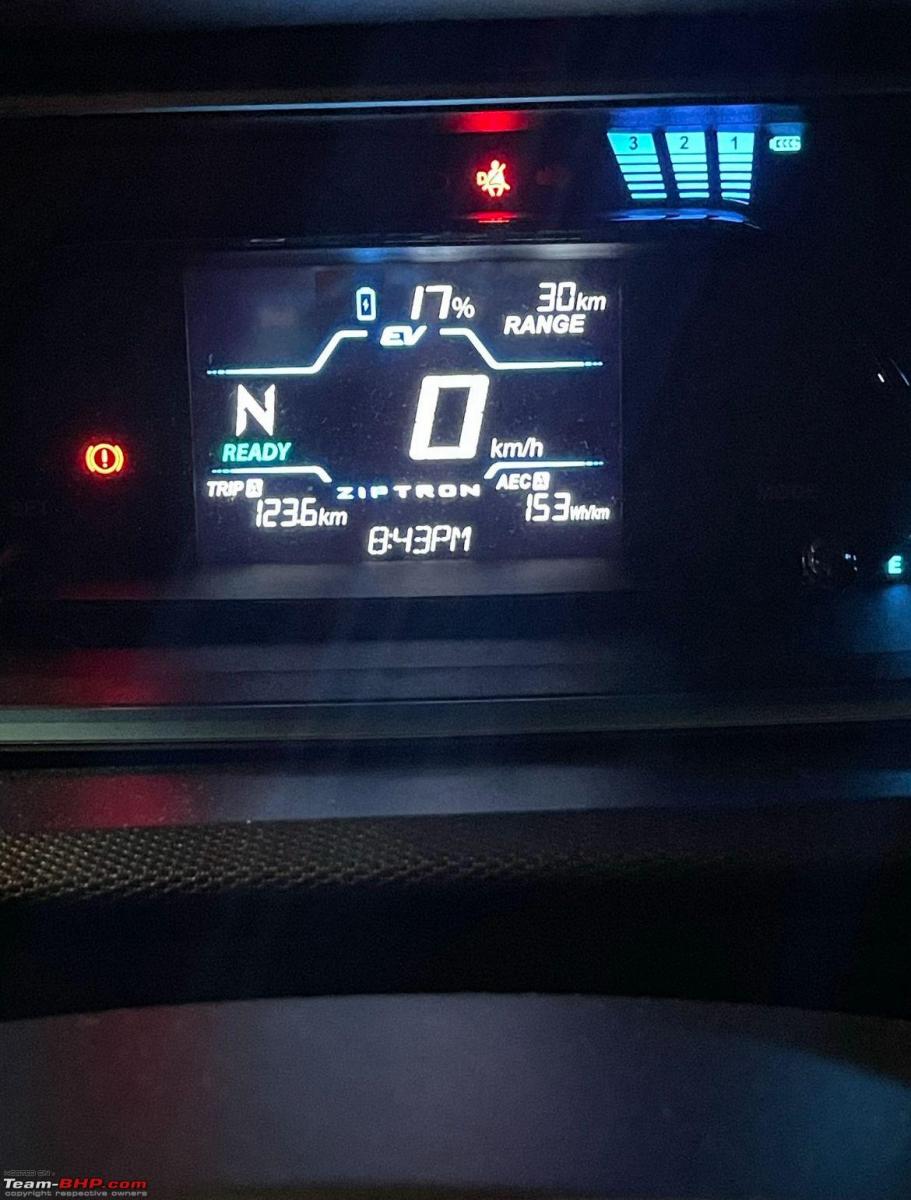
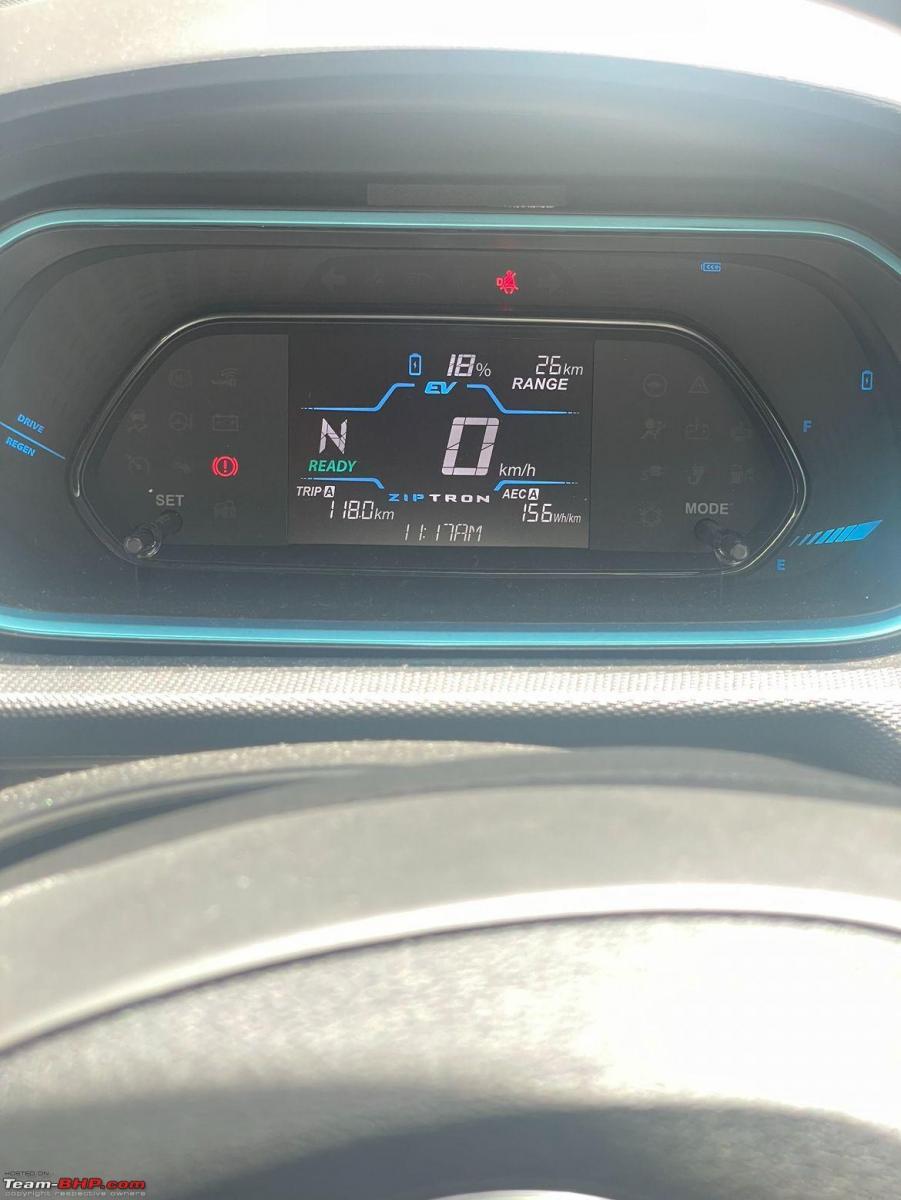
I had only heard about any car dealers services being terrible and this was my first time experiencing something like this ever and I had given up on the vehicle by now and felt completely helpless.
As I am a businessman based in Calicut, I did not have the time to go to the showroom directly and argue with the executive but with all the cars I have ever owned, this sales executive is the most irresponsible person I have ever met and did not care the least bit about his customers after delivery.
It Continues:
After another email to Tata Motors, I was finally contacted by another executive from Rotana Motors, Meenchanda showroom, which is an exclusive showroom for EVs, regarding the range issue and I was asked by the new executive to bring my “AEC” (charge consumption value) to below 100Wh/km by low acceleration, etc and at that time, the AEC value was somewhere between 140-155Wh/km.
This should have been explained to me by the first sales executive on the day of delivery but you all know by now how that went.
First Major Issue with Battery:
Over the next couple of weeks, I tried to bring down the AEC to below 110Wh/km but that was very difficult for me since the lowest I got it down to was 135Wh/km.
This went on for the next couple of weeks until 16-Sept-2023 where I was driving to the neighboring town which was 30km away. I started from my house with 68% battery remaining but after reaching a certain point, the vehicles total “range remaining” went down to 21km and soon showed “recharge” even when the percentage was showing 60% and the car had run a total of 74km including the trip we were on.

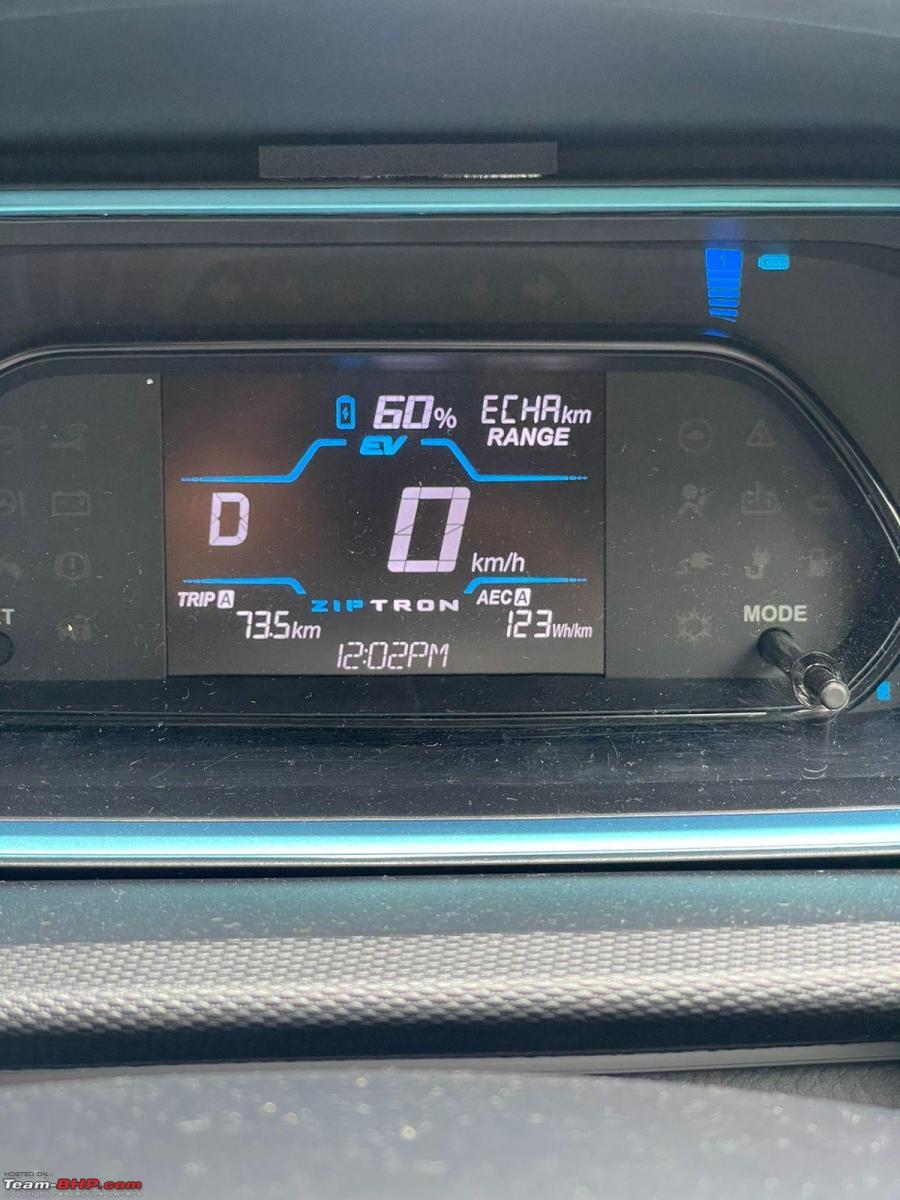
I reported this issue to the new executive who asked me if I could bring the vehicle to their service centre and I gave the car to get it checked myself after work. During this 30km+ drive from that town to the service centre, I noticed that the “range” which was supposed to go down from the then 21km was increasing and by the time I reached the service centre, the Range increased from 21km/recharge to 70km. Basically the entire range system was reversed.
Luckily the new executive was very helpful and checked the vehicle where it showed that there was nothing wrong with the vehicle and asked me to try to charge the vehicle to 100% and then if the issue still remains unsolved, he said he’d get the first service done as the vehicle was nearing 1000km mark and I thought hopefully that will solve the issue.
But the best part was that the new executive took me on a drive and showed me how to drive maintaining “AEC number” of the vehicle by reducing constant acceleration and braking and even using the regenerative braking correctly.
From that day, I drove the vehicle exactly like how the executive had demonstrated and I even managed to bring the “AEC value” to less than 110Wh/km and I was getting a range of 180km with 20% charge remaining where at 100% the vehicle even showed a range of 240km.
Limp Mode Issue:
I was conscious about my acceleration and braking after that and I wanted to check the full range of the vehicle since I had done that with one of my friends MG EV where we drove it down to 3% before we charged it.
I left for work with 20% charge and when the car hit 17% with 39km range, limp mode got activated and the AC got cut off and the cars power was reduced and the constant ringing noise was definitely a pain.
I was shocked when limp mode got activated at 17% because I had read somewhere that it usually only happens below or close to 10%.
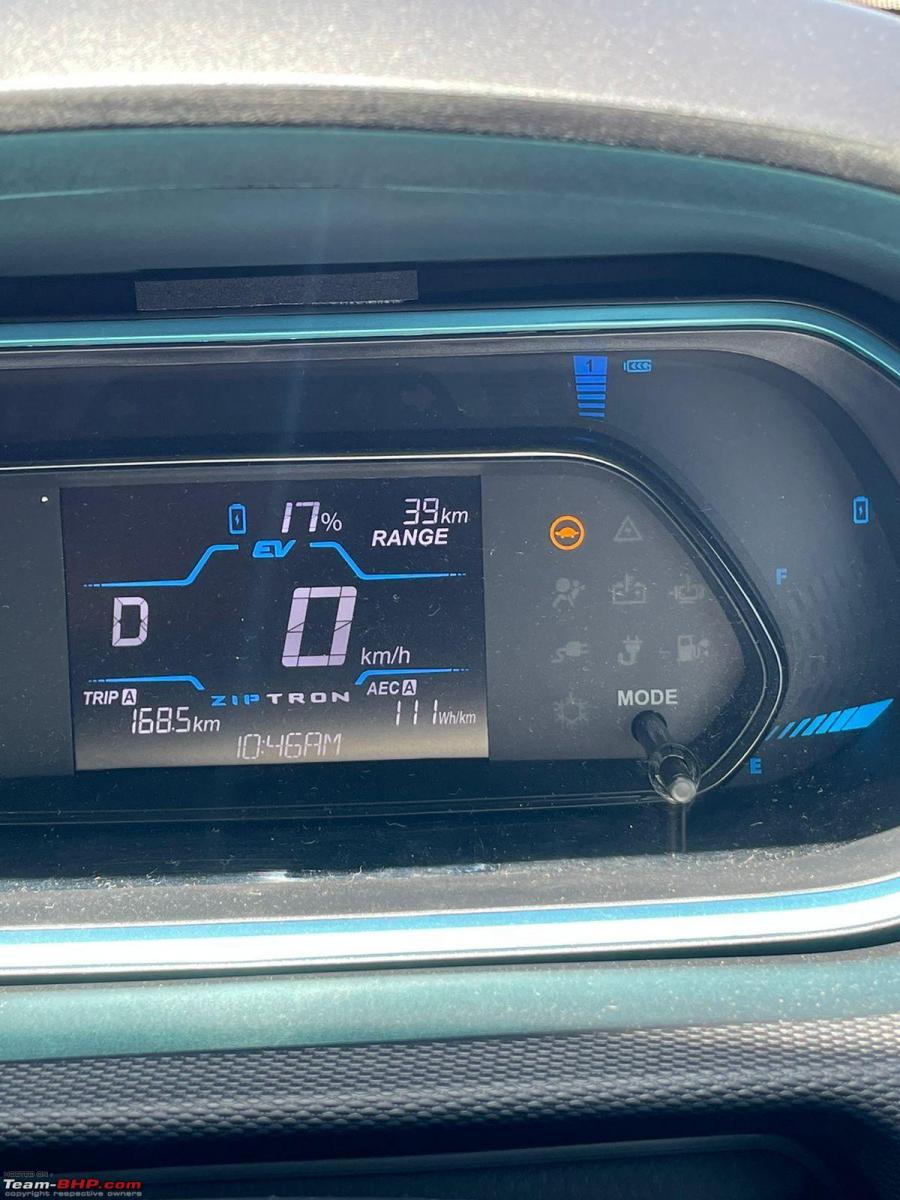
I booked for another appointment at the new service centre and they came and picked the vehicle unlike the first place and the executive called me up to say that no issue was being shown on the system and I was given the car back on the same day after more checkups. This is when I was convinced that the car had battery issues even though nothing was being shown on their computer.
Over the next couple of trips after 100% charge, limp mode got activated at 20% and this time the car was not getting charged when connected to the cable and just kept making the ringing sound from the dash. So I let the car cool down for a while and tried connecting the charger again after 30 mins and it started charging.
After completing that 100% cycle, limp mode got activated at 26% with 53km range on 17-Oct-2023. Imagine on a 180km realistic range car, the limp mode getting activated upon crossing 150kms?
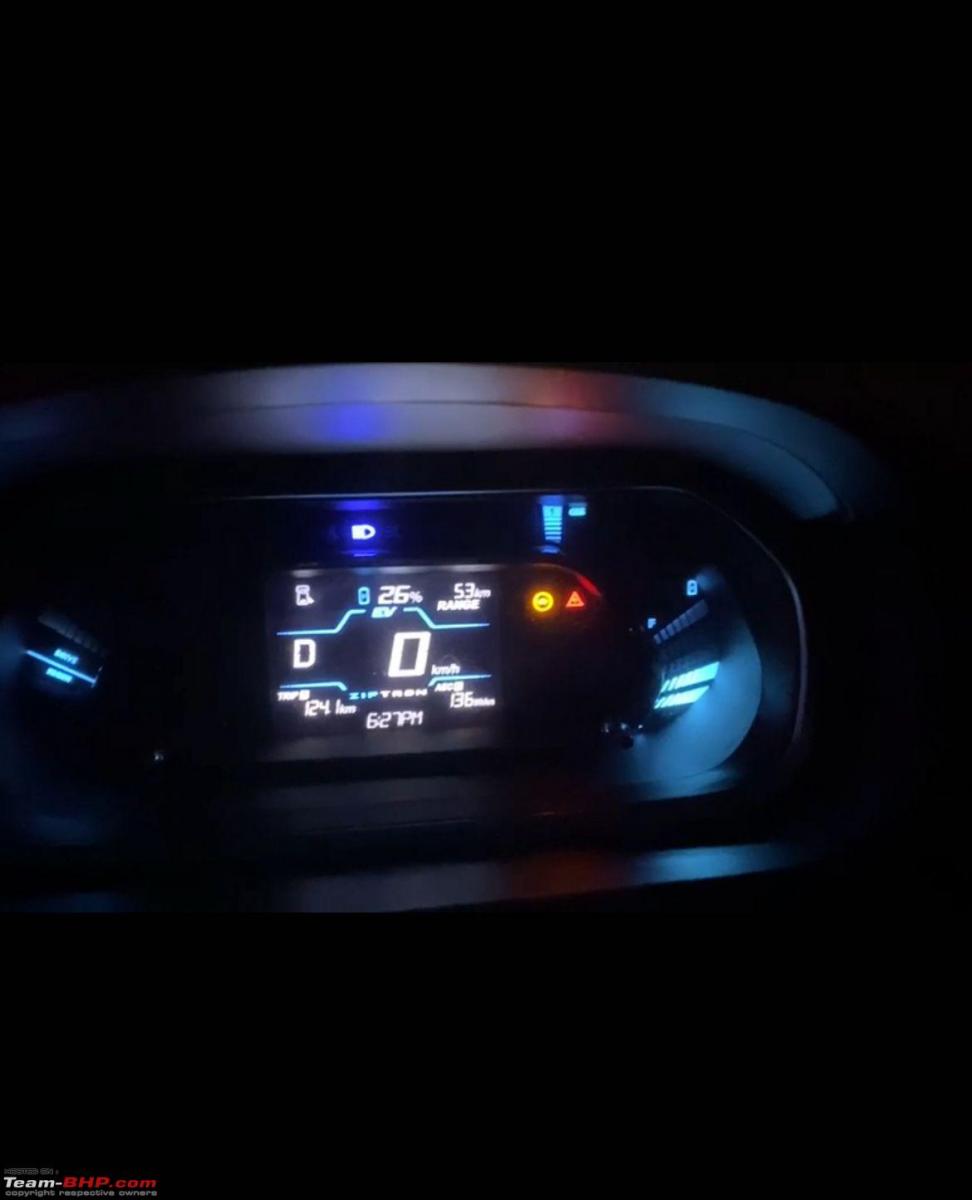
And then at 28% on 21-Oct–2023.
I just sent the video to the executive and did not bother explaining things anymore because I was already regretting buying this car. Basically, I had given up and did not know what to do. But I made sure all this was being reported to Tata motors, so I sent emails constantly regarding every single issue I have been facing then and when it happens.
Car break down and HV Alert:
On 22-Oct-2023, what I had feared officially happened.
My family had taken the car to church and the car did not turn on later. It just showed “HV Critical Alert” at 25%.

I called up breakdown service via Tata Motors customer care number and I must say that they were very professional and arrived on time. I had even called up the executive and he said he will look in to it 24-Oct-2023 as the showroom was shut on the occasion of Dussera.
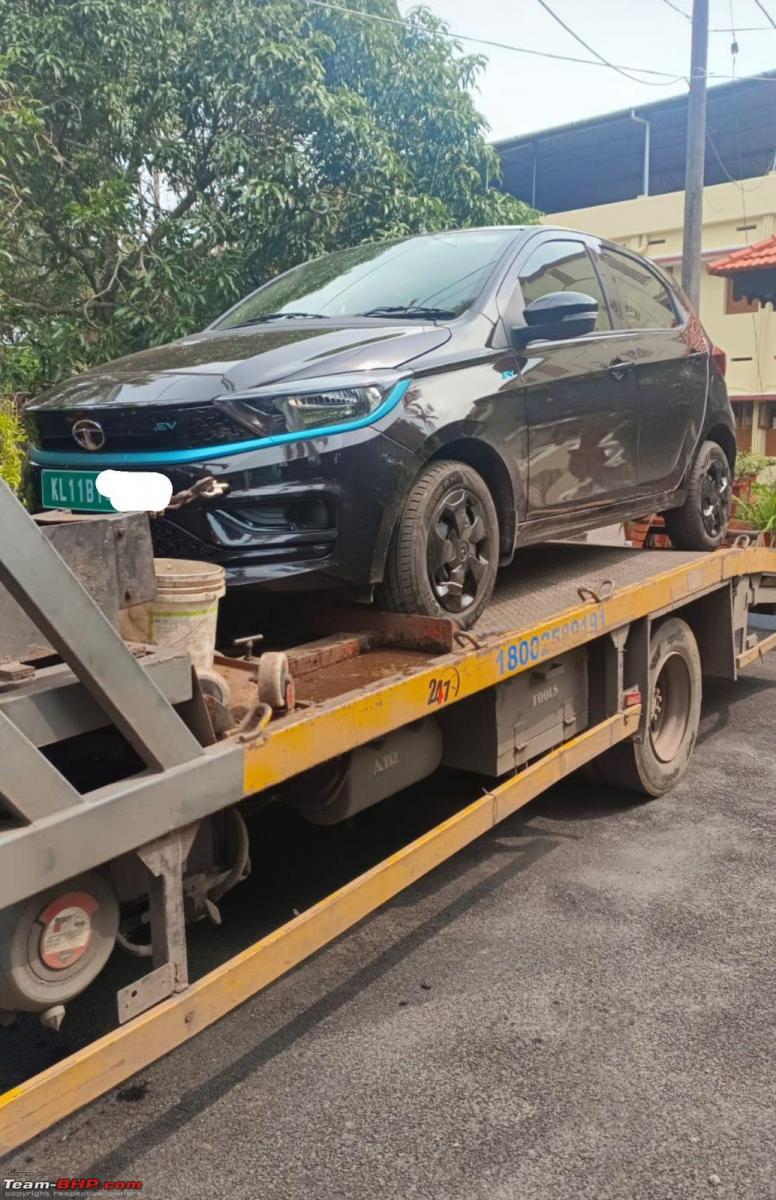
Battery Replacement and Temporary Car:
I was contacted by the executive on 24-Oct-2023 and he told me that the vehicle had battery complaints and would be fully replaced under warranty and I was later on contacted by the Service Manager and informed that it would take 15-20 days for the vehicle to be fixed since the battery has to arrive from their plant in Gujarat and I asked for a temporary vehicle during this period and he said that they do not have any vehicles readily available.
I am lucky to have another vehicle with me, but for someone who only owns this vehicle would have faced so many issues. But I told him that it is not possible and that they had to arrange a vehicle for me since we are a family of 4 and we all needed vehicles for work and personal purposes all the time, so he said I could rent a vehicle with Rs. 1000 as the per day budget where we would have the pay for the fuel and that made no sense to me.
After calling him every day, he said another vehicle that was given to another customer during his “Battery Change” period is back in the showroom. But the vehicle met with an accident while it was with the customer and it can be given only after fixing it.
As I write this on 02-Nov-2023, I am yet to get any updates regarding the temporary vehicle and it has been 11 days since my car broke down.
Conclusion:
My three month experience with the Tata Tiago EV has been far from satisfactory. What initially seemed like a promising solution for city driving turned into a nightmare of issues and disappointments.
From the very beginning, the sales executive’s very poor and irresponsible post-delivery support left me extremely unsatisfied. My optimism about the claimed 315 km range evaporated as the vehicle consistently fell short, with the real-world range proving to be just a fraction of what was promised.
I still think that if the car had worked properly, it would be the perfect option for city users like myself. But that was not the case obviously. I made a total of 6 visits to the service centre in 2 months (some registered visits and some unregistered).
I tried to save fuel money by buying an EV but I ended up stressing and losing my time instead.
I even called up the first sales executive to know if he can arrange a temporary vehicle for me, to which he said he will ask and get back to me and as you can guess, he has not contacted me till date. He should learn from other brands executives on how to treat a customer.
Being a family of 4 with members working in different fields, our daily commute itself has become really difficult. One of my relatives was considering buying a Tata Tiago EV or Nexon EV but I strongly recommended against buying any EV from Tata based on my personal experience and they have put the purchase on hold.
To conclude in simple words:
Do I regret buying this car?
YES.
Would I recommend this car to someone else based on my personal experience?
NO.
Was the switch from petrol to EV worth it, based on my 3 months experience,
NO, definitely not worth the hassle and stress.
My intention in sharing this review is to provide an honest account of my experience with the Tata Tiago EV, with the hope that it can serve as a cautionary tale for those considering this vehicle. Despite its promising size for city use and an okay range, the litany of issues I've faced makes it clear that this is not a vehicle I would recommend to anyone.
In my view, Tata Motors has a long way to go in addressing the reliability and quality concerns in their electric offerings. I would advise potential buyers to thoroughly research and consider alternatives, as my journey with the Tata Tiago EV has been nothing short of a disappointing and frustrating ordeal. Cheers! "
Although TATA looks like catering to the needs of customers, a huge void is to be filled in respect of after sales experience and training for staff. Hope TATA does something about the recurring complaints from customers regarding the above.
Check out BHPian comments for more insights and information.
Pages



